
 Brainerd MN Area Fishing Report October 31, 2024
Brainerd MN Area Fishing Report October 31, 2024
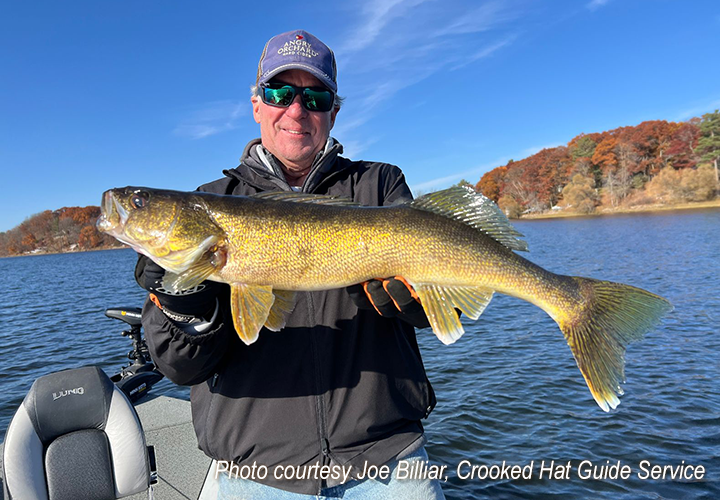 "Water temps in the area have remained stable despite cold nights. Smaller lakes are between 51-54 degrees for surface temperature. Walleyes can be found on the outside weed edge or off the deeper break. Green standing weeds are key to the shallower water bite. The walleyes off the deeper break are easier to find however require more effort to get bites. Working Lindy rigs with minnows ranging from 4-6” has been the most effective. The more lively the minnow the better.
"Water temps in the area have remained stable despite cold nights. Smaller lakes are between 51-54 degrees for surface temperature. Walleyes can be found on the outside weed edge or off the deeper break. Green standing weeds are key to the shallower water bite. The walleyes off the deeper break are easier to find however require more effort to get bites. Working Lindy rigs with minnows ranging from 4-6” has been the most effective. The more lively the minnow the better.
In addition to walleyes the musky bite is going strong. Dragging large minnows on bobbers is working along the weed edge. Staging the minnows 30-60ft behind the boat is working best for my trips. In addition big rubber can be worked to get more aggressive fish and cover more ground.
The weather looks to be stable for the next couple weeks. It might be warm for deer opener but will be great weather to continue the opener water season. With a few more trips this year yet we will be out until the baits bounce.
Good luck and tight lines to those still out!" — Joe Billiar, Crooked Hat Guide Service
 Wired2Fish October 31, 2024 "Should Professional Fishing Competition Have Age Limits?"
Wired2Fish October 31, 2024 "Should Professional Fishing Competition Have Age Limits?"
 "While some folks are leaning on the simple argument that forward facing sonar destroyed competitive fishing, what seems to be more at the heart of the issue is a lot more young anglers are competitive now than used to be the case.
"While some folks are leaning on the simple argument that forward facing sonar destroyed competitive fishing, what seems to be more at the heart of the issue is a lot more young anglers are competitive now than used to be the case.
One person mentioned on a recent post the possibility of having a senior fishing league, or another league with elder statesmen in it. Which is a much more interesting discussion point. But a question popped into my mind about whether professional fishing should have age limits much like other sports naturally do.
So professional fishing has allowed for anglers to fish into their 70s and 80s since inception. To my knowledge no one 90 or older has fished in a professional tournament. But that begs the question should we cap it? And would capping it make the league ..." Learn More >> Should Professional Fishing Competition Have Age Limits?
More Recent Fishing Reports
Brainerd 10-31 • Lake of the Woods 10-30 • Sundin 10-24 • Lake of the Woods 10-22 • Sundin 10-18 • Sundin 10-17 • Crappies 10-16 • Winnie 10-13 • Crappies 10-11 • Grand Rapids 10-10 • Winnie 10-9 • Winnie 10-8 • Ely 10-7 • Winnie 10-6 • Crappies 10-4 • MN DNR Workgroups • Sternberg 7-18 • Legal Bait Transport 6-1 • MN Record Fish • Barotrauma Study 1-25-24 • Fish Consumption • Forward Sonar • Panfish Workgroup • Follow on Facebook
 Lake of the Woods, LOW Tourism October 30, 2024
Lake of the Woods, LOW Tourism October 30, 2024
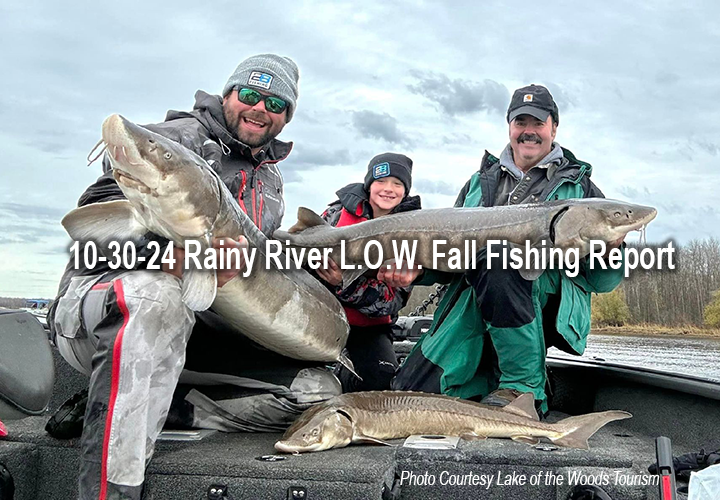 "Now is prime time to head up to Lake of the Woods (LOW) and the Rainy River. Fall fishing is in full swing on the south side of Lake of the Woods, and on the Rainy River! With plenty of limits of walleyes and saugers being caught, and a favorable weather forecast, anglers are enjoying some excellent fishing.
"Now is prime time to head up to Lake of the Woods (LOW) and the Rainy River. Fall fishing is in full swing on the south side of Lake of the Woods, and on the Rainy River! With plenty of limits of walleyes and saugers being caught, and a favorable weather forecast, anglers are enjoying some excellent fishing.
Dress for Comfort: With cooler mornings, dressing in layers is essential. Ice fishing gear is ideal for early mornings, and you can shed layers as the day warms. A warm hat and gloves or mittens are also handy.
The best bite on the south end of LOW has been in 22 to 28 feet of water. Water temperatures are dropping and as the temps cool further, the bite has been excellent.
Vertical jigging with frozen emerald shiners remains highly effective. Bring plenty of bait, as you’ll need to sort through some smaller fish, but you’re likely to land keepers as well as larger walleyes. Anglers have also reported good numbers of jumbo perch and occasional pike mixed in with the walleyes. Good Jig Colors: This week’s hot colors have been gold, gold/glow white, gold/chartreuse, gold/orange, and gold/pink.
On the Rainy River... Shiners and walleyes continue to move into the Rainy River, making it an ideal spot for targeting large walleyes. Anglers are experiencing success up and down the river, especially in areas throughout Four Mile Bay. Walleyes are being caught in various depths, but 15-25 feet of water has been good.
Jigging with live or frozen emerald shiners has been highly effective. Some anglers are also trolling crankbaits to cover more ground and find fish. Both methods are producing solid results.
Sturgeon Fishing: With cooler days and shorter daylight hours, sturgeon activity has picked up. Catch-and-release sturgeon fishing is open, providing anglers with an exciting opportunity to hook into these prehistoric giants.
Up at the Northwest Angle, fall fishing is firing on all cylinders. Walleyes continue to be concentrated around traditional areas with structure. Points, neck-down areas with current, shoreline breaks, and transition zones from rock to mud are all productive locations for walleye right now.
In addition to walleyes, anglers are catching pike, jumbo perch, and crappies. Using a jig and minnow is a tried-and-true approach and continues to yield excellent results. Muskie fishing is also hot this time of year, with anglers casting and trolling to find these predators. Big muskies over 50 inches are being caught and released.
For those looking to enjoy some fall fishing at its finest, now is the time to head to Lake of the Woods and the Rainy River. With cooling water temps, great weather on the horizon, and prime fishing conditions, it’s a fantastic opportunity to jig up some walleyes and saugers for a fish fry. So, bundle up, gather your gear, and come experience the unforgettable fishing that awaits you up north!" — Lake of the Woods Tourism, (800) 382-FISH
 October 24, 2024 "Never Too Late For More Fishing?"
October 24, 2024 "Never Too Late For More Fishing?"
Almost every year, there’s a day or two at the end of the fishing season when I wish I would have quit a little bit sooner. This season is not one of them, I could have fished at least another week, I think, and still been happy with the fishing action. Letters like this one that came via email from Steve explain why.
We've been fishing since Saturday on Winnie. Overall, the bite has been very good. Water temps are in low 50s and the south wind seems to have driven them to the north shore. We fished near Third River for a bit and limited very quickly with predominant 2018-year class. Yesterday we stayed away from boats but still fished along the north shore, between Pigeon River and Farley Creek. We located multiple pods, nice size containing 8 to10 fish each that were easily seen on side imaging. We would pick a couple off fish from each pod, and then move to the next pod. They seem very hungry and have aggressive bites.
We've been using the river mix of minnows from the Winnie Trading Post which MIGHT have been a factor to catching more fish. Our lures were all 1/8-ounce Jigs combined with the river mix minnows.
Perch fishing is decent over by dam in Tamarack Bay. We use small fatheads and a jig or drop shot in 8 to 10 feet of water. Sorting for larger perch took us a while, but we managed to put a couple meals together. We're going to try Cass for perch today (Wednesday), I have little experience there so we'll see how that goes. Will let you know. Take care, Steve”
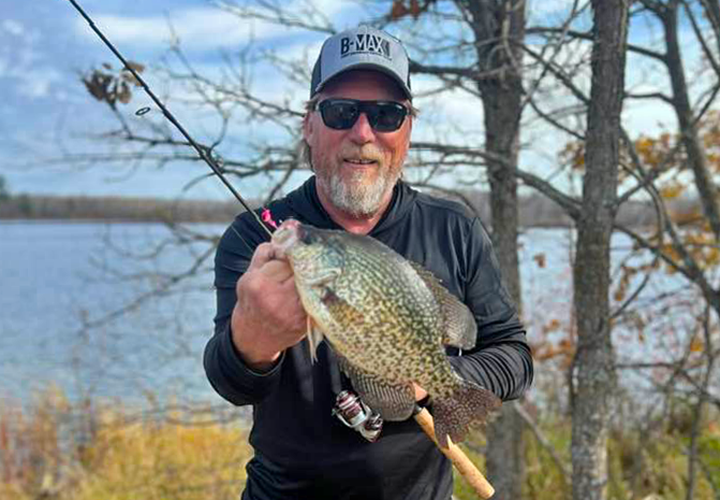 Indirectly, I see too that some of my friends are still out on the lakes having a good time. Steve Kusske for example, has been fishing for crappies. His report was succinct, “Fun morning this week fishing with my buddy Ryan, The Crappies were on fire.” There are lots of other folks reporting good crappie fishing too, and the swath of territory is wide. I’m seeing reports everywhere from the Detroit Lakes to Mankato and everywhere between.
Indirectly, I see too that some of my friends are still out on the lakes having a good time. Steve Kusske for example, has been fishing for crappies. His report was succinct, “Fun morning this week fishing with my buddy Ryan, The Crappies were on fire.” There are lots of other folks reporting good crappie fishing too, and the swath of territory is wide. I’m seeing reports everywhere from the Detroit Lakes to Mankato and everywhere between.
Typical fall patterns, suspended schools over mid-lake basin areas are the norm. Vertical presentations, Jigging Raps, jig and minnow, slip floats and tungsten ice lures tipped with waxworms are all producing fish. An Aitkin area angler who likes to fish during the evening reports catching crappies by slow trolling shallow running Salmo crankbaits, a few feet below the surface. Just before dark, suspended fish move higher in the water column to feed.
That crappie angler might be on to something that we haven’t talked about before. I remember fishing on a Bemidji area lake for suspended crappies during late afternoon. As the sun moved lower, the fish moved higher and at dusk, we caught our last few fish by dropping jigs and minnows over the side of the boat and stopping them in about 3 feet of water. I do think that this feeding pattern is common, but that many of us leave the lake(s) before it occurs.
Hypothetically, an angler who lives on, or frequently visits a lake in which crappies inhabit deep water during fall, could mitigate the impact of barotrauma by focusing on this evening pattern. What if fish that might otherwise be damaged by dragging them out of the depths could be safely released after being caught near the surface? It’s worth thinking about the possibilities, I think.
 Being preoccupied with fishing in north central Minnesota, I seldom mention it here, but there are awesome fall runs in southern Minnesota. When I first started my fishing guide service in Long Lake Minnesota, both the St. Croix and Mississippi Rivers were favorite fall fishing spots. Sauger, Walleye, Smallmouth Bass, Whie Bass and Catfish were common catches for us. Sauger and White Bass were the most common harvest, and both were delicious to eat. These days, I’m dissuaded from fishing in those places because of the travel time, but I still think about them often. I’ve wondered, is the fishing down there as good as it was when I fished them 40 years ago?
Being preoccupied with fishing in north central Minnesota, I seldom mention it here, but there are awesome fall runs in southern Minnesota. When I first started my fishing guide service in Long Lake Minnesota, both the St. Croix and Mississippi Rivers were favorite fall fishing spots. Sauger, Walleye, Smallmouth Bass, Whie Bass and Catfish were common catches for us. Sauger and White Bass were the most common harvest, and both were delicious to eat. These days, I’m dissuaded from fishing in those places because of the travel time, but I still think about them often. I’ve wondered, is the fishing down there as good as it was when I fished them 40 years ago?
Fishing reports from Luhmann's River Guiding in southeast Minnesota have gotten my attention lately. I began following some of Jerimiah's posts from Lake Pepin on his social media page. Right now, it looks like an awesome time to be fishing for walleye, sauger and white bass on that stretch of the river. And by the looks of their photos, I’d say that he and his customers are answering my questions. Photos from the fish cleaning tables show impressive catches coming in.
Without seeing specific reports about presentations, fishing patterns and the like, I’m hesitant to offer suggestions. That said, I do recall catching lots of fish during fall using Lindy Rigs tipped with fathead minnows. I imagine that the fishing presentation we used then is still good these days. Trolling crankbaits using the 3-way swivel and drop weight method was effective in those days too. Obviously, there are probably more “modern” presentations to try these days as well.
I did reach out to Luhmann for permission to share this photo, and he agreed. Maybe one of these days he’ll agree to offer some additional information in the reports, or maybe I’ll get lucky and land an opportunity to connect one-on-one for an in-depth look into my old stomping grounds.
The St. Croix River, I imagine is likely productive now too, and I’ll see if I can drum up anything about fishing there as well.
The MN DNR “Technology Workgroup” meets today, and I’ll be in attendance. Among the topics, a list of potential concerns about “forward facing sonar”, social media and angling ethics. I’ll offer a report recapping today’s discussion, later. Today though, before it starts at 11:00 AM, you can contact me privately using text or email. Let me know your thoughts or concerns and I’ll be happy to share with the group and let you know the reactions they have. ![]() — Jeff Sundin, The Early Bird Fishing Guide Office Cell Call or Text 218-245-9858 or Email
— Jeff Sundin, The Early Bird Fishing Guide Office Cell Call or Text 218-245-9858 or Email
 Lake of the Woods, LOW Tourism October 22, 2024
Lake of the Woods, LOW Tourism October 22, 2024
 "Now is a great time to get up to LOW and the Rainy River, there's a great weather forecast ahead and the fall fishing on Lake of the Woods is on fire!. There are lots of limits of walleyes and saugers coming in from the south end of the lake, and the river is getting better at the same time.
"Now is a great time to get up to LOW and the Rainy River, there's a great weather forecast ahead and the fall fishing on Lake of the Woods is on fire!. There are lots of limits of walleyes and saugers coming in from the south end of the lake, and the river is getting better at the same time.
Like any fishing, being flexible pays dividends. If you are fishing on a charter or with a guide, your guide will make necessary adjustments to put you on fish. If you are fishing on your own, here are some considerations.
- Walleyes and saugers are being caught in a variety of locations across the south shore from 18 to 25 feet opf water. Water temps are in the low to mid 50's.
Vertical jigging with frozen, or live emerald shiners is catching a pile of fish. Have plenty of bait as typically, lots of small fish to sort through but boats are getting their keepers along with some larger walleyes. Good numbers of jumbo perch and along with some pike are also being caught by walleye anglers. Good jig colors this week included gold, gold-glow white, gold-chartreuse, gold-orange, and gold-pink.
On the Rainy River, more shiners and walleyes moved into the river this past week. Nice walleyes are being caught up and down the river, including areas throughout Four Mile Bay. The morning and evening hours have had the best bite.
Jigging with frozen or live emerald shiners and trolling crankbaits have been the most popular methods of catching walleyes. 15 to 25 feet of water has been the norm. Sturgeon fishing continues to pick up as the days get shorter and the water cools. The "Catch and Release" sturgeon season is in place right now.
If water clarity isn't good as maybe a big blow has muddied up the water, find an area of cleaner water. This could be a different area of the lake or switching to or from the river or the Northwest Angle.
- Things change quickly. One group went way out on the lake from a resort on the river, only to get a call from their buddies the walleyes moved in the river. They came back and fished in front of their resort and limited out with nice fish. No wonder there were so many seagulls on the river that morning!
- Don't be afraid to trailer your boat to a different shoreline, which is often easier and more economical vs making long runs on the water, especially on days with some wind.
- Trailering your boat to different sections of the Rainy River is not only effective, it's enjoyable to learn other areas. So beautiful this time of year.
- Fishing reports, resort owners, guides, other anglers, bait shops, social media groups are all sources of info.
- Dress warm, be comfortable. Wear ice fishing gear in the morning when it is chilly. As the day gets warmer, shed clothing. Hat and gloves or mittens are also helpful.
Up at the Northwest Angle, it's been a great week of fall fishing up at the Angle. Walleyes are being found around traditional areas with structure. Points, neck down areas with current, shoreline breaks and transition areas from rock to mud are good right now. In addition to good numbers of walleyes, pike, jumbo perch and crappies being caught. A jig and minnow continues to be the staple presentation and very effective. Muskie anglers are both casting and trolling this time of year to find the predators in this part of the lake." — Lake of the Woods Tourism, (800) 382-FISH
 Wired2Fish October 22, 2024 "Cold Water Wormin’ with Larry Nixon"
Wired2Fish October 22, 2024 "Cold Water Wormin’ with Larry Nixon"
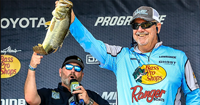 "Larry Nixon has a fishing tip for you: Don’t put your plastic worms away just yet.
"Larry Nixon has a fishing tip for you: Don’t put your plastic worms away just yet.
Most fishermen consider worms to be summer baits, at their best when they are slowly worked through heavy cover. But Nixon will tell you that they can lure big bass even in the fall and winter.
He should know. Nixon is one of professional bass fishing’s all-time greats, having won multiple tournaments on plastic worms.
“The plastic worm is absolutely a year-round bait,” said Nixon, who lives in Bee Branch, Arkansas. “It will work even in the middle of December and January when they’re not hitting anything else. “You can get right over the top of them, drop a straight-tail worm straight down and ..." Read Full Article to Learn More >> Cold Water Wormin’ with Larry Nixon
 October 18, 2024 "Walleye Smallmouth Combo Guiding Season Finale'"
October 18, 2024 "Walleye Smallmouth Combo Guiding Season Finale'"
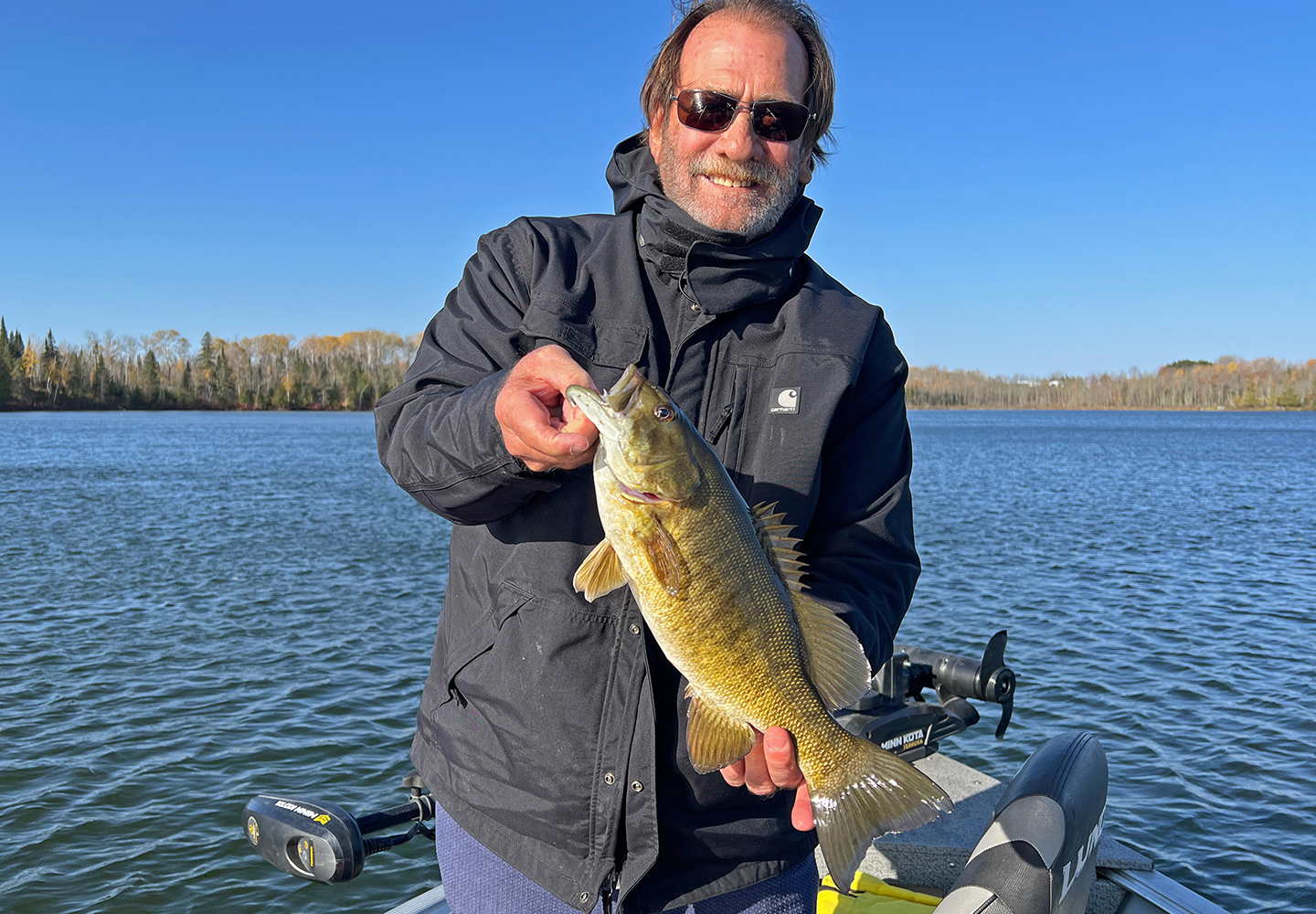 On one hand, I can’t say that I was looking forward to another day of fishing in 30 MPH winds. On the other hand, if the winds had been moderate, I might have missed out on a great way to wrap my 2024 “work fishing” season. Yes, I probably would have just taken Bugs and Steve out on their home lake, Winnibigoshish, and finished the season with an ordinary day of walleye fishing. Instead of that, the decision to hide from the wind on smaller waters landed us on a mixed walleye and smallmouth bass fishing trip.
On one hand, I can’t say that I was looking forward to another day of fishing in 30 MPH winds. On the other hand, if the winds had been moderate, I might have missed out on a great way to wrap my 2024 “work fishing” season. Yes, I probably would have just taken Bugs and Steve out on their home lake, Winnibigoshish, and finished the season with an ordinary day of walleye fishing. Instead of that, the decision to hide from the wind on smaller waters landed us on a mixed walleye and smallmouth bass fishing trip.
When we arrived at the lake, the parking lot was empty, and the landing ramp was bone dry. We could see whitecaps rolling across the water beyond the shallow bay where we launched. The surface water temperature was 51 degrees, and that never changed throughout the day. By the time we got out into the main lake, it was clear that fishing on the windy side of the lake wasn’t going to work, so we bounced across the lake in search of more manageable conditions.
I stopped at a point near the southwest corner and “spot locked” in about 16 feet of water. By the time I passed out the fishing rods and got the minnow buckets set up, the boat was rocking and rolling in whitecaps. Casting and retrieving jig and minnow combos at the weedline in about 10 feet of water. Bugs picked up one nice walleye quickly, but after that, small perch and a couple of pike was all we caught. “Well boys, it looks like one of those days when we’re gonna get pinned into the calm corner. Hopefully, we’ll be able to scrounge out some fish by jumping from spot-to-spot,” I advised.
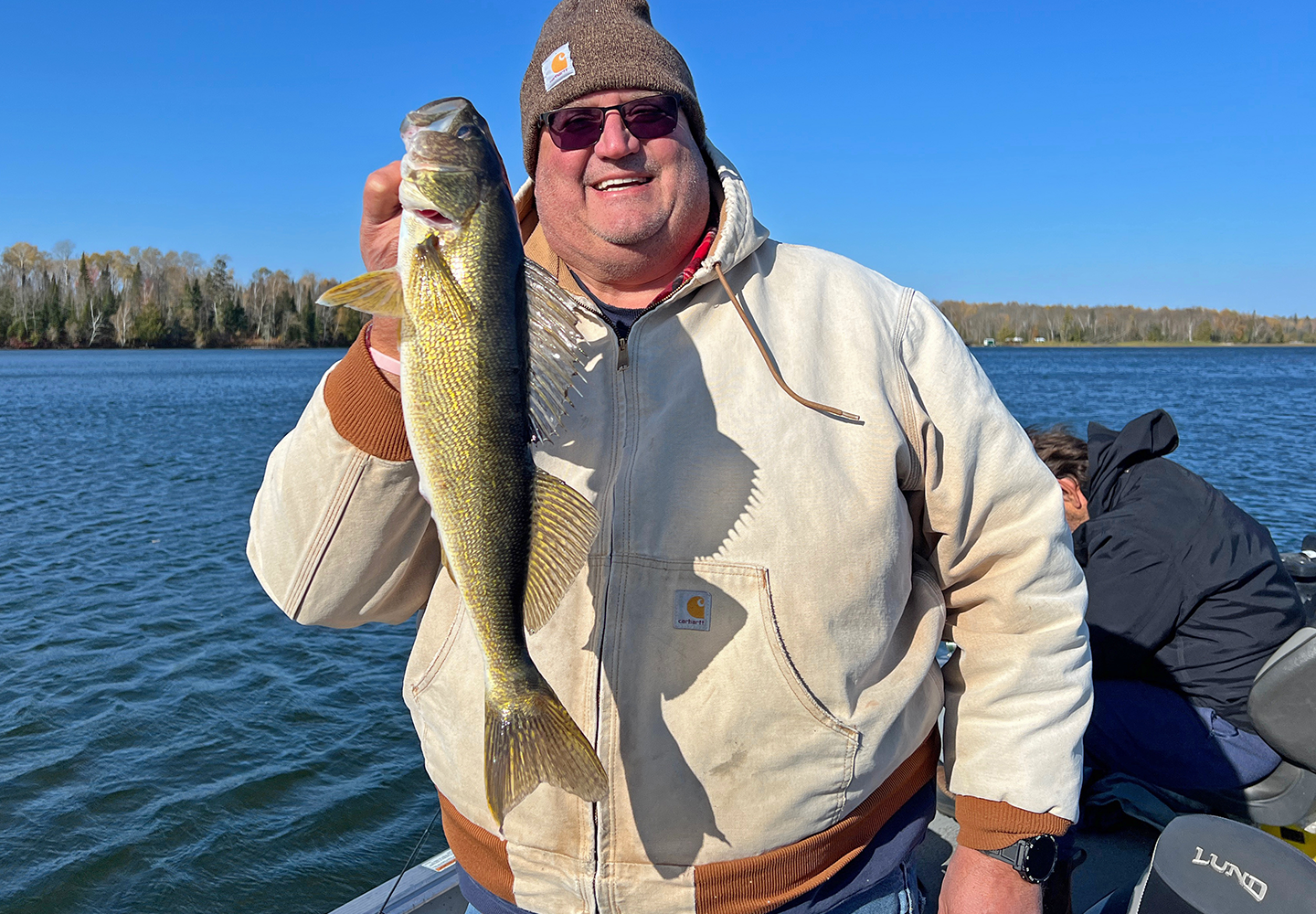 Watching my Lakemaster chart for ideas about where to stop, I motored down to the south side of the lake. There, I did something that I rarely do, I set up to troll through the calmest spot on the lake, a shallow bay with a thin weedline. “Sometimes this spot gives me a fish or two, but sometimes I can get more, it just depends on the day,” I told my crew. “I don’t really like fishing where the wind is blowing offshore, but I think I can force a drift with the trolling motor, and maybe those weeds are holding a few fish today,” I added. So, we got in position and started jigging on the outside edges of the weeds.
Watching my Lakemaster chart for ideas about where to stop, I motored down to the south side of the lake. There, I did something that I rarely do, I set up to troll through the calmest spot on the lake, a shallow bay with a thin weedline. “Sometimes this spot gives me a fish or two, but sometimes I can get more, it just depends on the day,” I told my crew. “I don’t really like fishing where the wind is blowing offshore, but I think I can force a drift with the trolling motor, and maybe those weeds are holding a few fish today,” I added. So, we got in position and started jigging on the outside edges of the weeds.
Some days I just get lucky, and this was one of them. Steve picked up a nice smallmouth bass, we got a picture and then released that fish. Not long after that he picked up a nice walleye and then we began picking away at more fish. The walleye action was slow-but-steady and by the time it ended, we’d amassed a larder of 7 keeper walleyes. We’d also released a few nice size bass and a lot of perch, so it felt like we’d been busy and our day was off to a good start.
Moving along the shoreline, searching for the next good spot, I stopped at several “rock spots”. Some free-standing bars with rocks, some shoreline points with rocks and one straight stretch of the shoreline that features a rocky flat. We always caught something at all those stops, but mostly they were not walleyes. I think we caught 4 or 5 more northern pike, 6 or 7 more smallmouths, and a lot of medium size perch. Through it all, there was only 1 more walleye added to the livewell, so I was searching for one more decent walleye spot. Analyzing where we’d fished, I said, “everyplace we fish on rocks we catch bass, but not walleyes. All I need to find is one more calm weedline that has fish on it.” Steve laughed, “yeah right, a calm weedline that has fish, easy!”
 It wasn’t easy, and it wasn’t all that calm either, but I did find one more weedline that had fish on it. It was on the calm side of the lake, but because it was further away from the shore, it was still windy. Like I said before, controlling the boat in an offshore wind doesn’t thrill me. But it was manageable enough to allow a forced drift along the weed edges. Just like before, a slow-but-steady walleye bite allowed us to add more fish to the larder. Bugs and Steve offered me an excuse to declare victory in the form of a last-minute walleye double header. We released one of those fish, kept the other and that gave us a grand total of 15, 12 for them, and 3 for me and the Hippie Chick to fry up.
It wasn’t easy, and it wasn’t all that calm either, but I did find one more weedline that had fish on it. It was on the calm side of the lake, but because it was further away from the shore, it was still windy. Like I said before, controlling the boat in an offshore wind doesn’t thrill me. But it was manageable enough to allow a forced drift along the weed edges. Just like before, a slow-but-steady walleye bite allowed us to add more fish to the larder. Bugs and Steve offered me an excuse to declare victory in the form of a last-minute walleye double header. We released one of those fish, kept the other and that gave us a grand total of 15, 12 for them, and 3 for me and the Hippie Chick to fry up.
Looking back on the day, there are two possible scenarios. One is that walleyes were only in the weeds, but not on the rocks. Smallmouth were caught in both types of terrain though, and we caught them in equal numbers on both. So, the other scenario is that walleyes were on some of the rock spots too, but we didn’t get them because our boat speed was too fast. Whenever we fished rocks yesterday, they were located where windier and wavier conditions forced faster speeds. But when I fished the weeds, they were in calm areas where we could move more slowly. In the windy places, my boat was moving anywhere from .9 to 1.5 MPH. In the calm places, I was able to hold speeds of .4 to .6 MPH. Maybe the smallies were willing to move fast, but the walleyes weren’t? It’s hard to say for sure, but it’s something to think about and personally, I favor the speed scenario over the habitat theory.
One other factor to think about was the proximity of our lures to the weed edges. Picture this, I’m holding the boat against an offshore wind, so my lures are closest to the weeds. Steve is sitting in the middle of the boat, his lure is somewhat close to weeds, but not as close as mine. Bug is sitting up in the bow and his lures are the furthest away from the vegetation. Take a wild guess, who was catching the most, or the least number of walleyes?
Most of the time, folks don’t think about seating positions, but I have to because I want my crews to catch the fish, not me. Yesterday, it took some “animated encouragement” on my part to convince my friend to give up his admiral’s chair in the bow and come sit beside me. But when he made the move sternward, his luck changed a lot. In fact, most of the walleyes caught during our late inning rally can be credited to Bugs’ fishing prowess. I think it’s because the bow seat was too far away from the weedline to fish if effectively. Conversely, whenever the bow seat is adjacent to the weedline, whoever fishes in that position suffers most by being snagged in the grass.
If I ever have the luxury of going walleye fishing as a passenger in somebody else’s boat, I’ll make a point of sitting next to the coxswain; that’s where the action is.
Under different circumstances, I would have loved to try a variety of presentations for catching the smallmouths. But because the main goal was to harvest walleyes, we stuck with using jigs and minnows. The blue-collar approach to catching bass may not be as glamorous, but it is very effective. That said, you might be interested in smallmouth as the primary target, and if so, they did seem to be pretty active. I recall that in last week’s fishing report from Arrowhead Outdoors, they too mentioned that smallmouth bass have been on the move.
A few days ago, (See Report 10-16-2024) I offered readers a chance to advise me about the best way(s) to keep track of their lures position when fishing for suspended panfish. Overwhelmingly, using a bobber stop, without the bobber, set at the desired depth was offered as the best method. One reader, Bill, says, “I have found for suspended fall fish the best method to use to maintain contact and get away from the boat is using a slip bobber and a small jig, 1/32 to 1/80 of an ounce. Small plastics, sometimes as small as 1 inch usually work at this time of year.”
I do think Bill’s advice is good for crappie fishing, but for sunfish, I prefer not using a float. It may just be me, but during fall, the sunnies seem to pick and peck at my baits. I’m not sure that most of them would hold on to the bait long enough to be detected by a bobber. Still, I’ll give Bills advice a try, maybe it will work like a charm.
As of this morning, I am officially off the clock as a fishing guide. Any fishing I do from here on out will be to experiment with new lakes, or to produce more fishing reports. I might not be quite as active as over the past 5 months, but I’ll be around. So, keep an eye on the report’s pages for updates.
And remember, your fellow anglers appreciate your reports, even the most basic ones. A simple note about water temperatures, lake levels, or fish activity can go a long way to making someone’s trip more enjoyable. Drop us a line anytime, your comments are always welcome!
![]() — Jeff Sundin, The Early Bird Fishing Guide Office Cell Call or Text 218-245-9858 or Email
— Jeff Sundin, The Early Bird Fishing Guide Office Cell Call or Text 218-245-9858 or Email
 October 17, 2024 "Walleye Fishing Update"
October 17, 2024 "Walleye Fishing Update"
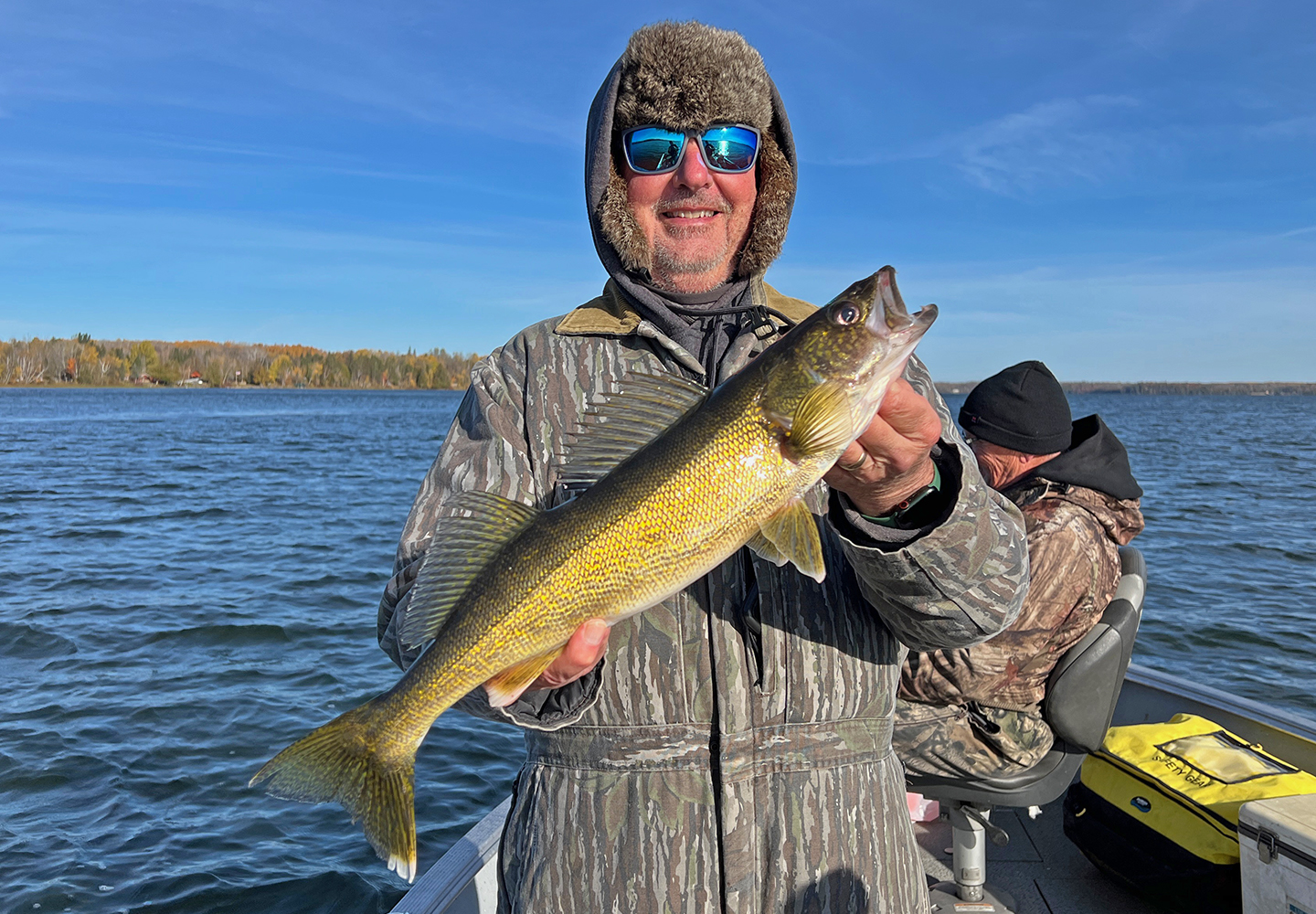 Walleyes were on the agenda this Wednesday, but not on Winnibigoshish. My crew got trapped in big waves last month and they all agreed that the heavy south winds forecasted made that option a bad idea. So, I decided to make a 2nd trip to the lake I wrote about back on October 2, 2024. The lake, a relatively small, 3000-acre lake has a reputation for decent fall fishing and has plenty of structure to explore. So even if I hadn’t been there much this season, I wasn’t too worried about not finding something to do there.
Walleyes were on the agenda this Wednesday, but not on Winnibigoshish. My crew got trapped in big waves last month and they all agreed that the heavy south winds forecasted made that option a bad idea. So, I decided to make a 2nd trip to the lake I wrote about back on October 2, 2024. The lake, a relatively small, 3000-acre lake has a reputation for decent fall fishing and has plenty of structure to explore. So even if I hadn’t been there much this season, I wasn’t too worried about not finding something to do there.
When we launched the boat, my surface temperature reading at the landing wa 50 degrees. By the time we were fishing on the main lake, 52 degrees was the average reading. The wind, as expected, was blowing hard and there were whitecaps rolling across the water. My strategy was to drive to the south side of the lake, hopefully, I’d find decent fishing where the waves were moderate. If necessary, I’d move north a little bit at a time until I figured out the best place(s) to fish.
The first spot was a dud, we didn’t catch a single fish on that free-standing, 12-foot-deep rock bar. “Okay, maybe they’re still in the weeds”, I offered. I moved us over to another free-standing bar, this one covered by a large patch of northern milfoil, the thick vegetation still growing to the water’s surface. I set the boat up for a controlled drift along the outer edges of the weed patch. We caught a walleye on the first pass, and then a couple more on subsequent drifts. The fish were holding along a relatively short patch of the weeds, so as an experiment, I spot-locked the boat within casting distance.
Pitching jigs and minnows instead of drift fishing isn’t too difficult, but often takes a little practice. So, we didn’t start catching fish immediately, but as the boys got the hang of it, walleyes started showing up in the landing net. I suppose we fished on that spot for a couple of hours, and by the time we were done, we had 12 walleyes in the livewell. The next couple of moves produced fish too, all of them walleyes that were within the protected slot, so the larder didn’t grow for a while. By now though, it was apparent that fish were biting well enough to be confident that we’d catch some more “keepers”.
Eventually, I stopped at a windy point that lays adjacent to both weeds and rocks. Here, drifting was not an option, and in the whitecaps, spot-locking wasn’t going to be much fun either. Instead, I backtrolled, moving slowly into the waves as the crew jigged along the breakline. There was room in the livewell for 6 more walleyes, and if all 3 of the crew were in top form, we’d have gotten them here. But a few missed fish, and a couple of “long distance releases” held us back from filling their limits before the spot fizzled out.
 The next couple of spots didn’t work out, there were too many rocks and in the waves, it was too tricky for us to fish without being snagged up constantly. Eventually, I did wind up on one more fishable spot where we bagged the last couple of fish. With my crew’s limits in the livewell, I started moving back toward the landing, checking out a couple of my favored spots along the way. The further north we moved, the windier it was, and in the really big waves, not much happened. Maybe it was a coincidence, or maybe the heavy current was too much for fish to handle? No matter the reason, we had little reason to continue fishing, so we put the boat on the trailer and headed toward the Gosh Dam Place for their fish fry.
The next couple of spots didn’t work out, there were too many rocks and in the waves, it was too tricky for us to fish without being snagged up constantly. Eventually, I did wind up on one more fishable spot where we bagged the last couple of fish. With my crew’s limits in the livewell, I started moving back toward the landing, checking out a couple of my favored spots along the way. The further north we moved, the windier it was, and in the really big waves, not much happened. Maybe it was a coincidence, or maybe the heavy current was too much for fish to handle? No matter the reason, we had little reason to continue fishing, so we put the boat on the trailer and headed toward the Gosh Dam Place for their fish fry.
I mentioned jigs and minnows as our presentation earlier and that was the only method we used yesterday. Lindy’s 1/8-ounce live bait jig tipped with a variety of minnows from the river mix. I preferred smaller size minnows over the larger ones on this trip. Fatheads or rainbows in the 3-inch size range seemed to be the best, but even some of the smaller, 2 to 2-1/2 fatheads worked.
When we are spot-locked, or anchored and fishing from a fixed position, the cadence of pitching and retrieving the jig and minnow is important. Cast the jig toward the structure(s) you want to fish, let it sink toward the bottom and then retrieve using a vertical hop-fall-hop-fall presentation. Your jig will come through weeds more easily than it would using a more horizontal approach. For me, 1 hop, followed by one turn of my reel’s handle seems to work best. One hop, one turn, one hop, one turn and so on. With each turn of the handle, I pause just long enough to feel for a strike.
When a fish picks up the bait, I keep reeling both slowly and steadily, maintaining light tension on the rod tip. This keeps the fish interested and reduces the frequency of fish dropping the lure. When they do drop the bait, I tease them back on by immediately going back to the hop-drop retrieve. It’s amazing how determined they can be, sometimes coming back 3 or 4 times to grab the bait after they’ve dropped it. Don’t give up the effort until you’ve proven to yourself that the fish is not going to come back again.
Remember too that bait position is more important than the distance you cast your lure. Try to position your boat just far enough away from the structure that you can reach it with a comfortable, medium-distance cast. On weed edges like we fished yesterday, I want my bait to fall along the outer edges, within a few feet of the weeds, but not in them. Try also to position your lure so that it runs parallel to the weed line as long as possible. The longer the baits linger along the weed edges, the better the odds of it being spotted by a fish get. Practice makes perfect, the longer you fish using this method, the better you’ll like it.
Today, unless something changes, is my last workday of the fishing season. I’ll probably do a little exploring of “new” lakes like I usually do at this time of year. So, I’ll be around and posting updates as long as possible before my attention turns to hunting, grandkids and guitar playing. ![]() — Jeff Sundin, The Early Bird Fishing Guide Office Cell Call or Text 218-245-9858 or Email
— Jeff Sundin, The Early Bird Fishing Guide Office Cell Call or Text 218-245-9858 or Email
 October 16, 2024 "Suspending the Suspend-Able"
October 16, 2024 "Suspending the Suspend-Able"
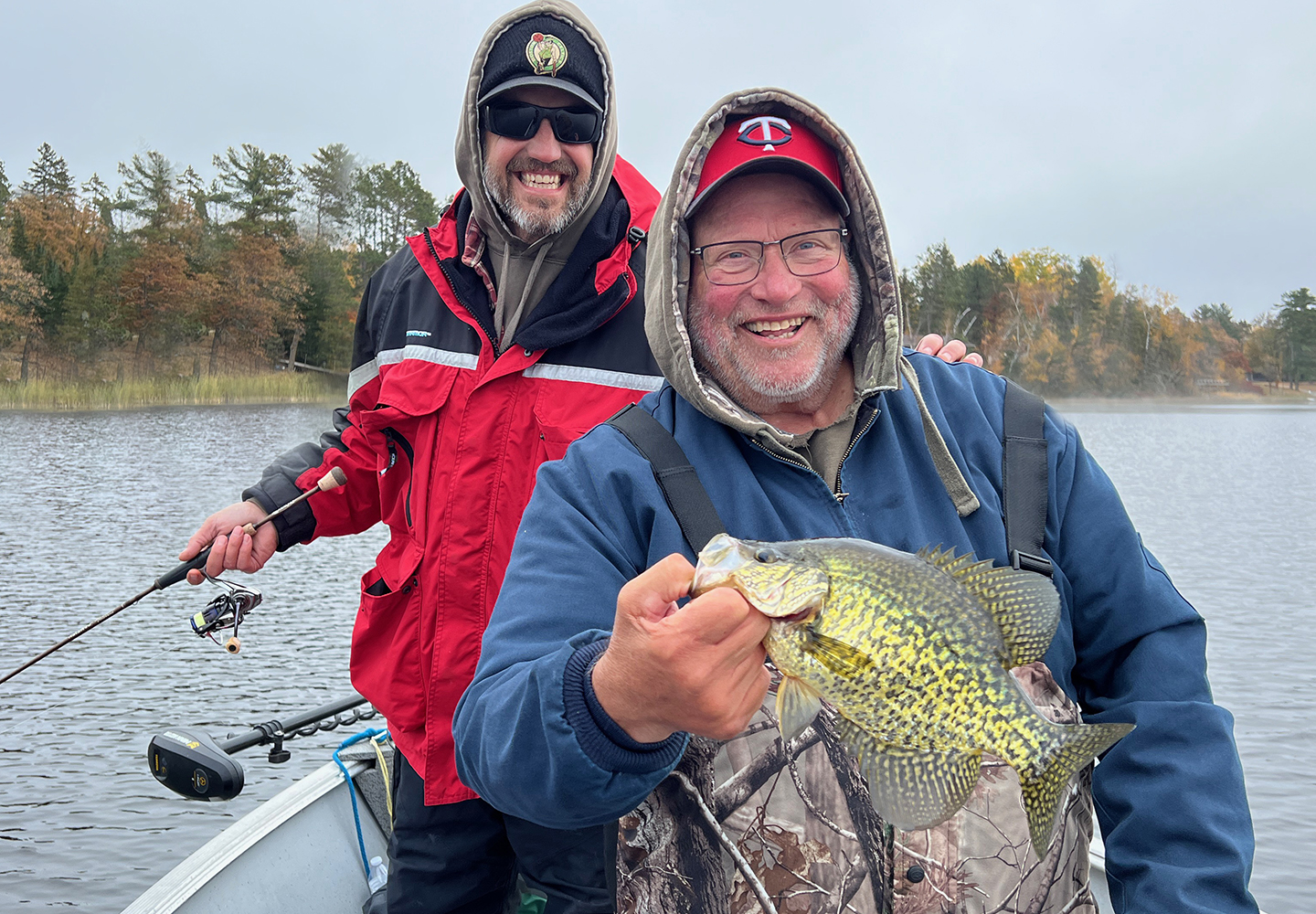 In crappie school, threatening suspension for misdeeds is not an effective form of punishment. No, they love being suspended and that would just make them happier. And happy they were on Tuesday, not only suspended high above the bottom of the lake, but also away from the shoreline, headed toward the lake’s deepest holes.
In crappie school, threatening suspension for misdeeds is not an effective form of punishment. No, they love being suspended and that would just make them happier. And happy they were on Tuesday, not only suspended high above the bottom of the lake, but also away from the shoreline, headed toward the lake’s deepest holes.
Understand, the movement, or so-called migration doesn’t necessarily mean that crappies must travel long distances. In certain lakes, migration could take them just a few hundred feet from summertime haunts. In some lakes though, they may travel miles to find preferred wintering habitats. In fact, when possible, they may go so far as to leave one lake, and swim into other connected body of water. The trick to finding them during fall is to figure out where the lake offers them the best available habitat.
On Tuesday, most of the fish we located were in, or near the center of the deepest holes we could find. Some fish related more closely to breaklines, others we in the centers of holes, but all of them were suspended well above the bottom. Crappies tended to be deeper than sunfish, but the two species were mixed together more than I expected.
As the experimenter, I fished for sunfish while the crew focused on catching crappies and was able to capture quite a few of them. For me, a 1/16-ounce orange Lindy Jig tipped with waxworms did the trick. To make holding position, and steadying my presentation easier, I added a large split shot sinker to my line about a foot above the jig head. Except for one crappie, and three dogfish, I caught only sunfish on my rig.
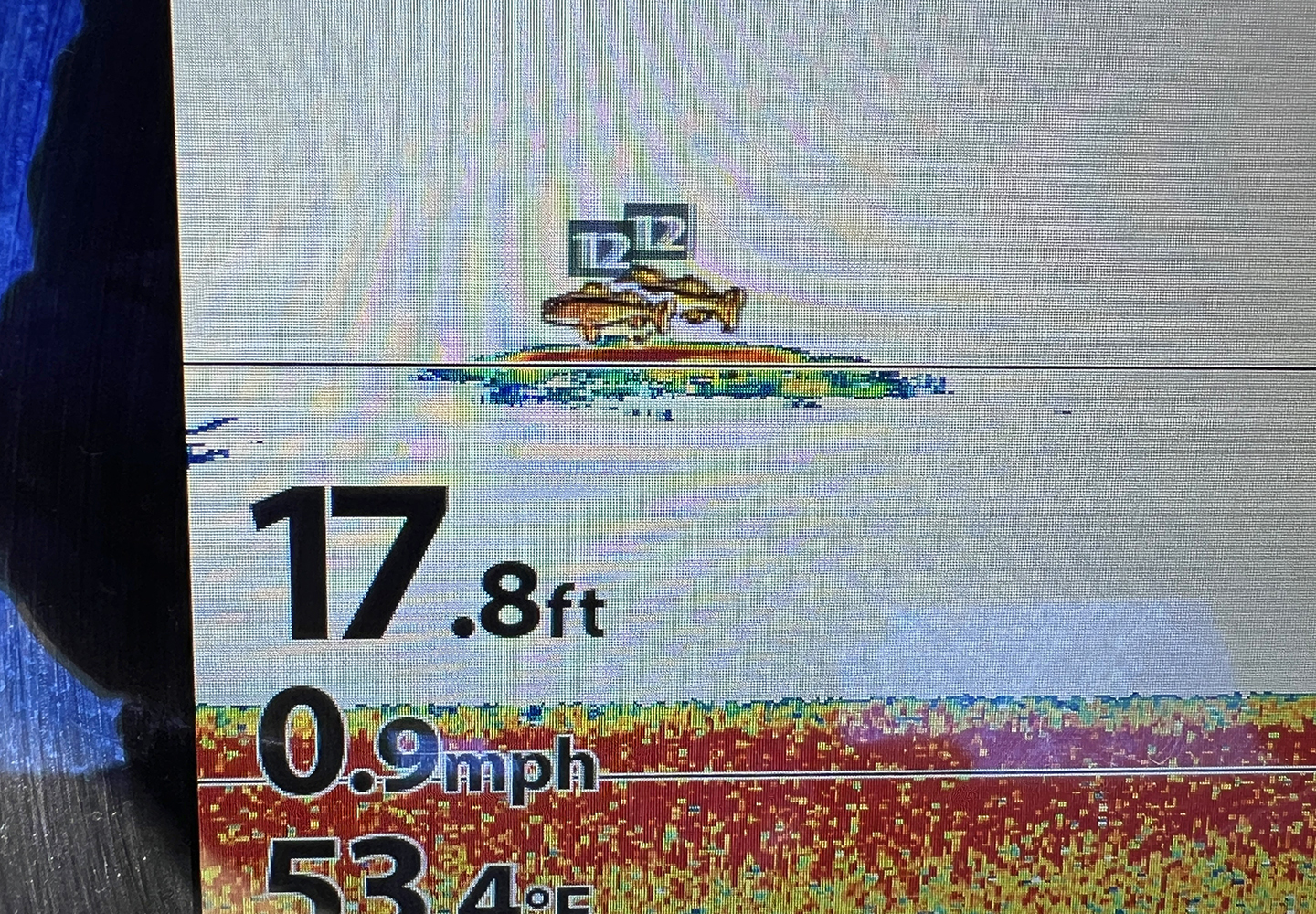 My crew was fishing with 1/8-ounce Lindy Jigs tipped with small fathead minnows. It seemed that the crappies preferred gold jigs yesterday, but our experimentation was minimal. For the most part, Bill and Matt caught crappies, but there were a couple of sunfish that struck the minnows. It was clear that catching a mixed bag of sunnies and crappies required using different presentations.
My crew was fishing with 1/8-ounce Lindy Jigs tipped with small fathead minnows. It seemed that the crappies preferred gold jigs yesterday, but our experimentation was minimal. For the most part, Bill and Matt caught crappies, but there were a couple of sunfish that struck the minnows. It was clear that catching a mixed bag of sunnies and crappies required using different presentations.
Surface water temperatures ranged between 53 and 55 degrees depending on the location. Overnight low temperatures will encourage further temperature declines, and that makes me a bit nervous. I’m hopping that the water stays in the “fish catching zone” through the upcoming weekend, we’ll know about that soon enough.
While we were fishing yesterday, we talked about some of the methods that we used to hold our lures at the correct depths for catching suspended fish. I’m curious, when you’re fishing for suspended fish, what are your favorite methods for holding your lures at the proper depths? Let us know, so we can pass the information along to your fellow anglers.
Today, I’m back to Walleye fishing, but looking at the windy weather forecast, not leaning toward fishing on Winnie. We’ll see how the plan unfolds and let you know what happens tomorrow morning. ![]() — Jeff Sundin, The Early Bird Fishing Guide Office Cell Call or Text 218-245-9858 or Email
— Jeff Sundin, The Early Bird Fishing Guide Office Cell Call or Text 218-245-9858 or Email
 Lake of the Woods, LOW Tourism October 15, 2024
Lake of the Woods, LOW Tourism October 15, 2024
 "Fall fishing on the south side of Lake of the Woods is excellent right now. Water temperatures are in the low to mid 50s and the colder water temps have the fish snapping.
"Fall fishing on the south side of Lake of the Woods is excellent right now. Water temperatures are in the low to mid 50s and the colder water temps have the fish snapping.
Walleyes and saugers are being caught in a variety of locations across the south shore in water depths ranging from 20 to 27 feet. Jigging with frozen, or live emerald shiners is catching a pile of fish. Anchor up and jig over the side of the boat. Typically, lots of small fish to sort through but you will get your keepers along with some larger walleyes. Jig colors to consider are gold, glow white, glow red, chartreuse, orange, and pink. Gold combined with any one of these colors is often a good choice.
The Rainy River continues to get better and better with more walleyes moving into the river each week. Good fish being caught in many sections of the river. The morning and evening hours have had the best bite. Four Mile Bay is also holding some nice walleyes as they make their way in from the lake. Various areas on the edge of the current and channel break are good spots to begin.
Walleyes are being caught using three methods, jigging with frozen or live emerald shiners, pulling spinners and trolling crankbaits. The key depths are ranging between 15 to 25 feet of water, these have been the norm.
Sturgeon fishing continues to pick up as the water cools. The "Catch and Release" sturgeon season is in place right now. The river also holds a myriad of species of fish. Crappies, pike, smallmouth bass, suckers, bullheads and even an eelpout or two are being caught up and down the river.
Another great week of fall fishing is being reported up at the Northwest Angle as well. Walleyes are keying in on various areas with structure. Points, neck down areas with some current and transition areas from rock to mud are good right now.
Walleyes are the most sought after but in the fall, lots of muskie and crappie anglers are around as well. Good reports on a variety of species including jumbo perch and pike as the waters cool. Put on some warm fall clothes, make sure your camera is ready and make some incredible fall fishing memories. There is still time to get in that last fall trip." — Lake of the Woods Tourism, (800) 382-FISH
 Reader Comments October 15, 2024 "Lake Winnie Feeding Times"
Reader Comments October 15, 2024 "Lake Winnie Feeding Times"
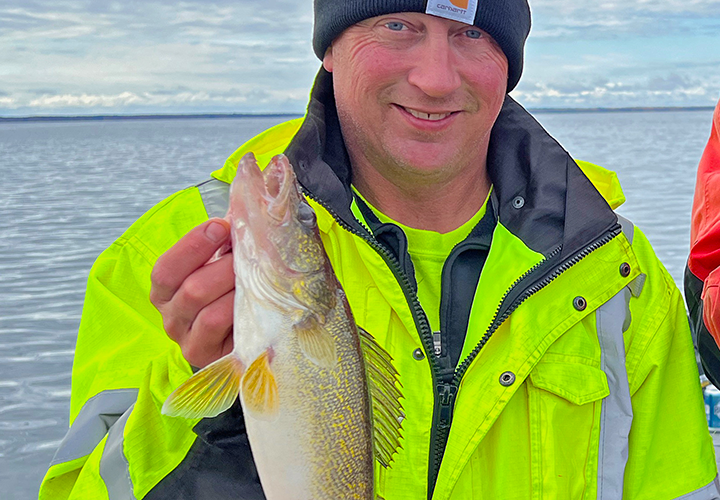 Here's a reader comment regarding my "working theory" about walleyes feeding heavily at night, resulting in a slow start to many morning fishing trips. (See Lake Winnie fishing report October 13, 2024)
Here's a reader comment regarding my "working theory" about walleyes feeding heavily at night, resulting in a slow start to many morning fishing trips. (See Lake Winnie fishing report October 13, 2024)
"Dave Allen wrote: "Good morning Jeff. Your thoughts on the Winnie walleye not being hungry in the mornings can be partially confirmed by my experiences on the big pond over the last three years.
I fish at night pulling crankbaits and this summer have fished exclusively on Winnie an average of 2 to 3 times per week. From the fishing opener until early August, I was fishing 1 hour before sunrise until shortly after sun up. Fishing at that time, the norm was catchoing 15 to 20 fish on each outing. By early August, I was forced to switch over to fishing from 1/2 hour before sunset until a couple of hours after sunset each day in order to catch similar numbers of walleyes.
I and some others who pull crankbaits at night have had the same thoughts about "full walleyes" and slow feeding early in the day. Proof that these fish are full is the very fat bodies we've noticed since mid August. Fattest dang walleyes I've ever seen on Winnie. Anyway just wanted you to know that others are having the same thoughts." Dave Allen
 October 13, 2024 "Connecting With the Connect-Able"
October 13, 2024 "Connecting With the Connect-Able"
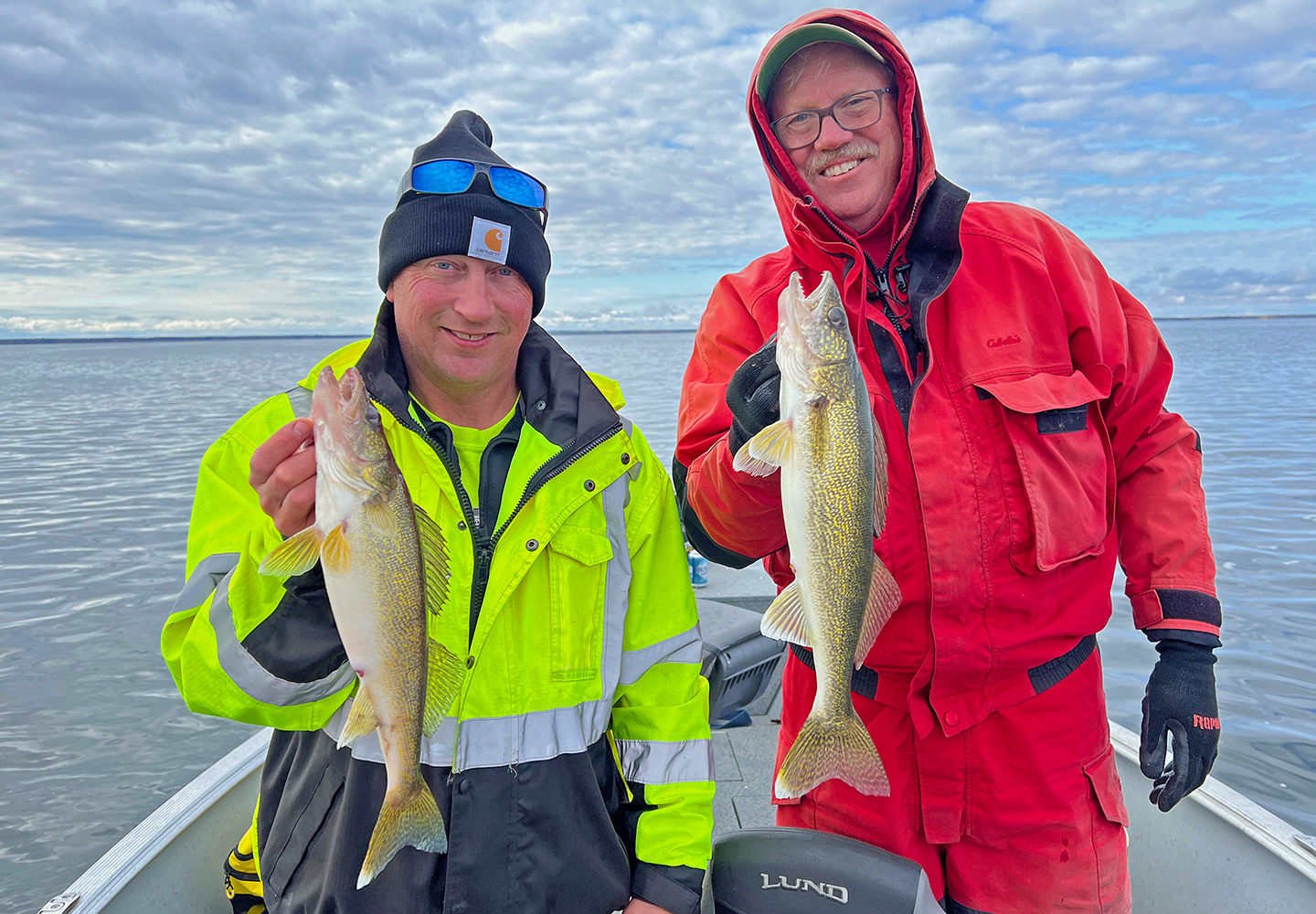 The photo of my friends Tom and Brad with their walleye double is gratifying, but it did not come without effort.
The photo of my friends Tom and Brad with their walleye double is gratifying, but it did not come without effort.
Lake Winnibigoshish was stingy with her walleyes during the morning hours on Saturday. That wasn’t just my opinion, friends who were fishing the lake on Saturday morning reported similar struggles. It would have been easy to believe that the fish weren’t biting, and that our efforts to catch them were futile. But if we’d succumb to the temptation of thinking negatively, we might have talked ourselves right out of catching not only these 2 fish, we might have missed out on catching the rest of their 12 fish limit too, but that’s speculation.
The fish were not, not biting, I didn’t think, and I told that to my crew repeatedly. “We just have to keep looking and keep fishing until we find the bunch of them that’s active. There’s just something going on with the timing this morning,” I advised. Why was I optimistic? Because the water temperature was still above 56 degrees, the cloud cover and the gentle southeast breeze was encouraging, and we hadn’t had any major change of weather. I couldn’t see any reason not to be optimistic.
What was going on, I think, is in part, the same thing that’s been going on for the past 6 weeks. First, walleyes have been feeding heavily at night and when we first start fishing in the mornings, they’re still full of food from their overnight gorging. Later in the day, they get hungrier and become more active. The Hippie Chick will confirm this, she’s received many a noon time text from me, reporting slow fishing and an empty live well. Likewise, she’s been receiving an equal number of late afternoon texts reporting that my crew’s bag limits are filled, and that I’m headed toward home.
The second problem yesterday was a dark black cloud hanging over the region. I can’t say if that cloud caused a drop in barometric pressure or what, but it was somehow connected to our low productivity. “When that cloud moves out of here, and the skies brighten, we’ll do better, I repeated to the boys”. I might just have an overactive imagination, but you can see for yourself that in that photo of Tom and Brad’s walleye double, the brighter, bluer skies moving in our direction.
Anecdotal stories from the lake are hard to quantify, so take my observations for what they’re worth. The only thing I can say is that for me, fishing was and has been better during the afternoons. The rest of the 6-man party who were on this trip and fishing independently also reported better action during the afternoon. So, if you’re thinking about heading toward the lake this week, maybe it’s better to sleep in, start late and fish until sunset.
From the technical perspective, our fishing presentations have changed little over the past couple of weeks. For me, calmer days make fishing on the mid-lake bars a better idea than targeting fish on the shorelines. Yesterday, fishing 16 feet of water along the upper edges of the structures was best. Occasionally, I found small packs of fish deeper, in the 20-to-22-foot range. The deeper fish were harder to entice than the shallower ones though and eventually, I disregarding seeing them, and kept the boat in 16 feet of water.
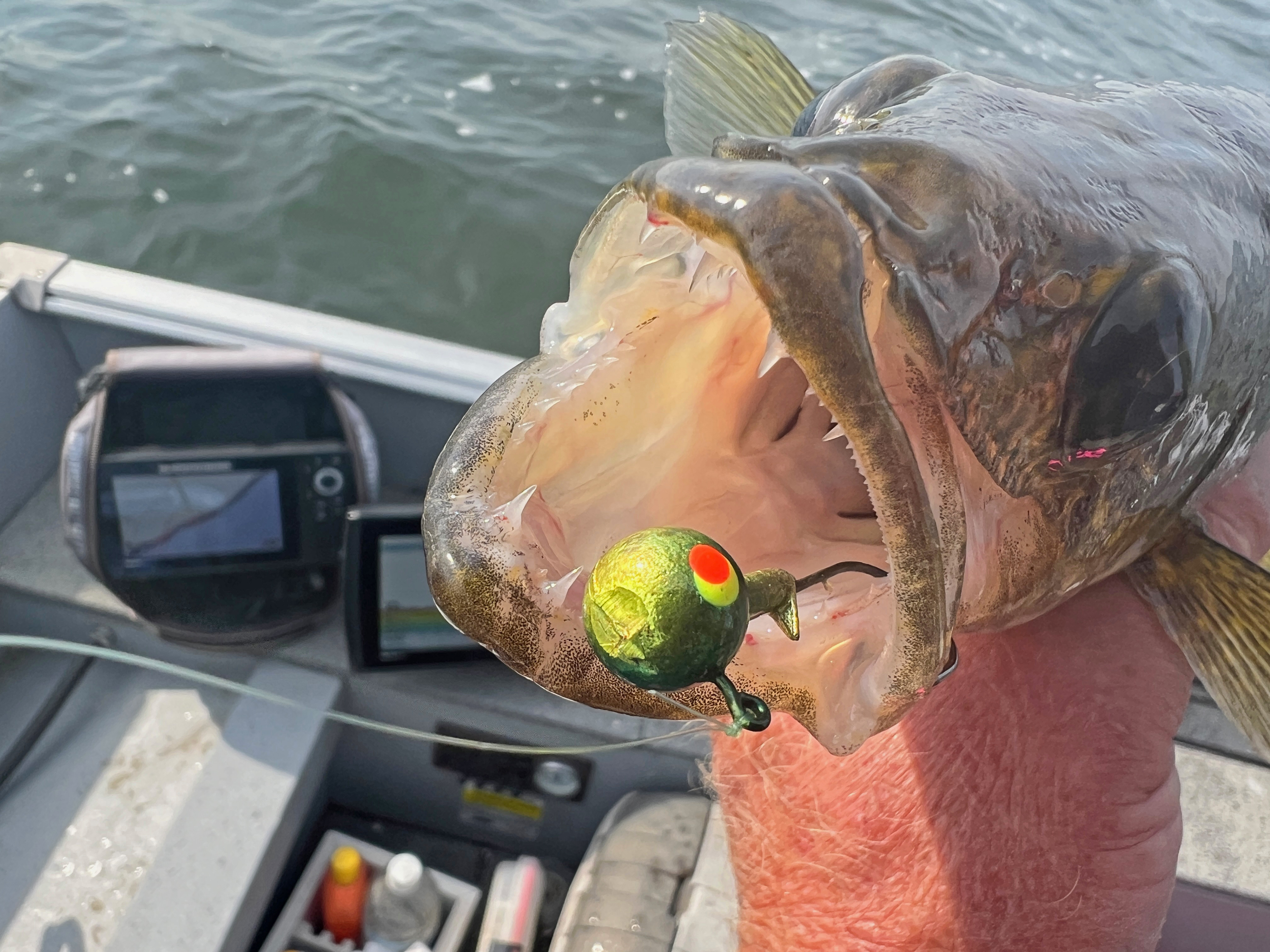 Slow trolling speeds were important yesterday too. We did our best work whenever I maintained speeds of .4 to .6 MPH. In the cold water, walleyes need time to pick up and inhale the baits, and faster speeds made them more likely to drop our lures before we could set the hooks effectively. There were numerous soft, slow strikes resulting in fish dropping the baits. That said, there were also enough aggressive strikes to make things interesting. Unlike me, Brad was able to catch fish without suffering through long periods of teasing his fish onto the hooks. So, experiment with your own hook setting style, and adapt to whatever you think is working best for you at the time.
Slow trolling speeds were important yesterday too. We did our best work whenever I maintained speeds of .4 to .6 MPH. In the cold water, walleyes need time to pick up and inhale the baits, and faster speeds made them more likely to drop our lures before we could set the hooks effectively. There were numerous soft, slow strikes resulting in fish dropping the baits. That said, there were also enough aggressive strikes to make things interesting. Unlike me, Brad was able to catch fish without suffering through long periods of teasing his fish onto the hooks. So, experiment with your own hook setting style, and adapt to whatever you think is working best for you at the time.
Minnow size was more important than minnow species I think. We were using “the river mix” purchased from Fred’s Bait in Deer River. In that mix, there are some larger size golden shiners, lake shiners and dace. For me, anything over about 4 inches long either gets discarded or saved to be used with Lindy Rigs. Any minnow from 3 to 4 inches, regardless of species, gets used on the jigs and any minnow shorter than 3 inches is used up when trolling spinners, or for fishing perch and crappies. If you can find them, large fatheads in that 3-to-4-inch range would be perfect, so would rainbows or golden shiners of the same size.
Our jigs, ¼ ounce live bait jigs have been working fine, and was the main presentation yesterday. Using a subtle, hop-drop-hop-drop presentation worked better than any aggressive snap jigging style. In the shallows, snappier jigging styles are fine, but on mid-lake structure, using heavier jigs, tone it down and you’ll have better results. For a time, I also tried fishing with a Lindy Rig, tipped with some of the larger minnows. That trick did not produce a single strike on this trip, but sometimes they work great.
Recently, non-toxic jigs made of tungsten or bismuth are making the scene. Because of that, I’ve been reminded of my own days in the jig making business. I sorted through some old boxes and dragged along some of my own non-toxic jigs (photo right) I made as a special order for a customer some 20 years ago. I’ve been fishing with them on recent trips, and they’ve been working very well for me. I’m particularly impressed with the hooks that I used to make them, premium, ultra sharp VMCs; they are a joy to fish with.
 I don’t have any plans of getting back into the jig business, but I would be interested in consulting with folks who have small operations and can experiment with designs, painting and the like. If you know someone who’s in that category, let them know that I’d be willing to chat.
I don’t have any plans of getting back into the jig business, but I would be interested in consulting with folks who have small operations and can experiment with designs, painting and the like. If you know someone who’s in that category, let them know that I’d be willing to chat.
I’m into the last full week of my fishing season and will be on the water most of the next week, but not today. I, along with the Hippie Chick, will be headed for the 2024 annual family pumpkin carving party. The accompanying photo, from our 2023 extravenganza included some of our kids, Kate, David and Joelle. The grandkids pictured, Charli, Lander and Augusta will be there again, but there's a new one, 4 month old Ryder tagging along this year too. Our favorite "other" grandpa will be there too! This summer, my pumpkin plants produced 13 small, but very attractive pumpkins and we’re going to carve them up for Halloween.
With all the excitement, I might not have time to produce a full scale, firsthand fishing report tomorrow. I’ll be happy to post any tips or suggestions that you want to share though. As always, remember that you do not need an invitation, just send a short note or a picture and I’ll include it in the daily updates for your fellow anglers to enjoy. ![]() — Jeff Sundin, The Early Bird Fishing Guide Office Cell Call or Text 218-245-9858 or Email
— Jeff Sundin, The Early Bird Fishing Guide Office Cell Call or Text 218-245-9858 or Email
 Wired2Fish October 13, 2024 "Tips for Catching Crappies from Scattered Hard Cover"
Wired2Fish October 13, 2024 "Tips for Catching Crappies from Scattered Hard Cover"
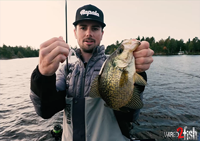 "Kobie Koenig and Adam Pavek head out crappie fishing on a sprawling Canadian Shield lake, where finding fish is a needle-in-a-haystack proposition. The duo uses cutting-edge fish finder technology to locate crappies around submerged trees, boulders, and other isolated structures. Koenig explains that crappies can be elusive and often spread out, making them difficult to find. However, they quickly identify high-percentage spots and fish using a mix of forward-facing sonar, side imaging, and even 2D sonar.
"Kobie Koenig and Adam Pavek head out crappie fishing on a sprawling Canadian Shield lake, where finding fish is a needle-in-a-haystack proposition. The duo uses cutting-edge fish finder technology to locate crappies around submerged trees, boulders, and other isolated structures. Koenig explains that crappies can be elusive and often spread out, making them difficult to find. However, they quickly identify high-percentage spots and fish using a mix of forward-facing sonar, side imaging, and even 2D sonar.
The team focuses on casting jigs and safety pin-style spinners in 10- to 15-feet of water, adjusting their presentation based on conditions. While the list of best crappie baits is long, Koenig highlights the versatility of a hair jig, which can be fished at different depths and manipulated in various ways to attract bites. When crappies are suspended, live sonar helps pinpoint them, allowing Koenig and Pavek to ..." View Video and Learn More >> Tips for Catching Crappies from Scattered Hard Cover
 October 11, 2024 "Wrapping Up Ruling out Rules and Accepting the Exceptions"
October 11, 2024 "Wrapping Up Ruling out Rules and Accepting the Exceptions"
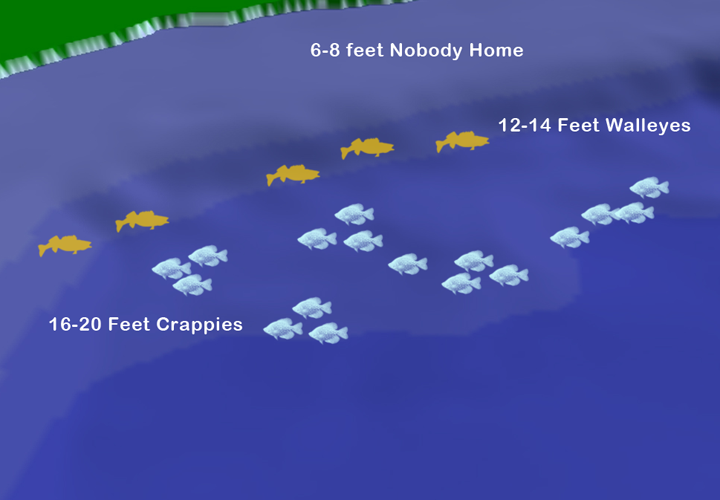 In yesterday’s report, I used up most of my morning writing time on Q&A about fishing for walleyes in clear water. I promised that I would finish reporting about Wednesday’s (10-10-2024) fishing trip with Dave and Brett, so here goes.
In yesterday’s report, I used up most of my morning writing time on Q&A about fishing for walleyes in clear water. I promised that I would finish reporting about Wednesday’s (10-10-2024) fishing trip with Dave and Brett, so here goes.
The theme, “Ruling out Rules and Accepting the Exceptions” describes our experience to a T. In search of walleyes, we explored shallow water, deeper water, weedy patches, steep breaklines, mid-lake humps and sandy flats. We covered lots of water, and looked everywhere I could think of … except the lake’s most prominent crappie holes. I avoided the crappie spots because as we left the dock, my first instruction was “we can’t catch any crappies, we already fished for them, and caught our limits yesterday,” my crew advised.
At the time, that aviso didn’t worry me because catching walleyes in open water where crappies school up during fall is rare anyway. Sure, it happens occasionally, but most often walleyes, in my experience, prefer structure over open water at this time of the season. That thinking, and my avoidance of fishing in “the crappie holes” may have been a mistake. Why? Because during the last half hour of our trip I sort of gave up on walleyes and turned my attention to catching a northern pike. I’d learned that my crew like eating them and would have been happy to catch some.
I know that pike feed on crappies, and often, they will cruise areas where crappies are concentrated. I reasoned that fishing closer to the crappies might help us catch a pike or two before we ran out of time. That’s when I stumbled into what might have been the solution to locating walleyes when I couldn’t find them anyplace else.
Picture this, crappies are schooled up over a 20 foot deep hole located close to a relatively steep shoreline drop-off. On the shallow side of the drop-off, there’s a shallow flat in water depths of 5 to 7 feet of water. We’ve already fished over that shallow flat, and found nothing. We’ve already fished the deeper hole and caught crappies. The narrow band of water laying between the two, a moderately tapering break from 12 to 16 feet of water was the place where we caught our only walleye. We caught a pike there too, that was in the protected slot and released it.
I didn’t fully realize what happened until I was driving home. Recalling my experience on this day and comparing it to the day when I fished for crappies on the same lake with Hippie Chick last week, it struck me. She caught a walleye, in a different spot that featured a similar structural layout. What if I couldn’t find walleyes because I was looking for them everyplace except where they were? I had just spent almost 5 hours purposely avoiding spots like this because I didn’t want to catch crappies, but the only time we caught one was when I did fish closer to the crappie hole.
My “working theory” is that if I would have spent more time fishing close to, but not in the deeper water crappie spots, I might have found more walleyes on spots like this one. If I wouldn’t have been so strict in my avoidance of crappies, I might have discovered that the thin band of water between the shallows and the deep holes may have been where a large percentage of the lake’s predator fish were located.
It’s unlikely that I’ll get to test my theory this week, but when and if I get the chance, I will. When I do, I’ll let you know how it goes.
 Yesterday, I was back on Cutfoot Sioux and Winnie for a walleye/crappie combo trip with Diane Eberhardt and her son Ryan. We spent the morning fishing on the big lake for walleyes, then moved into Little Cutfoot to search for crappies.
Yesterday, I was back on Cutfoot Sioux and Winnie for a walleye/crappie combo trip with Diane Eberhardt and her son Ryan. We spent the morning fishing on the big lake for walleyes, then moved into Little Cutfoot to search for crappies.
For the most part, walleye fishing patterns were the same as what I’ve offered for the past week of reporting. Surface water temperatures are stable, holding in the 56-to-57-degree range, water clarity was unchanged, 13 feet of clarity according to my Secchi disk. We caught our walleyes using ¼ ounce jigs and minnows and fished on a shoreline related bar in water depths of 16 to 20 feet.
The weather conditions, moderate southeast winds combined with hazy skies made catching walleyes somewhat easier than usual. We were able to locate several small schools of walleyes scattered along the breakline. When we found them, they struck willingly and were somewhat less wary than they have been on brighter days. Yesterday, they allowed us to make an extra, 2nd drift over them with decent results. Boat shyness was still an issue though, after 2 passes on any spot, the action fizzled out. By about 1:00 PM, we had 12 fish for the crew, and 2 for a dinner at my house, so we moved on to the crappies.
Crappies have not seen my boat in either Cutfoot or Little Cutfoot anytime this season, so this was my first experience searching for them. I looked at 3 spots on Big Cutfoot that have been good for me in the past. On Thursday though, I did not find crappies on any of them. I’d been hearing decent reports from friends who have fished recently in Little Cutfoot, so we moved up there.
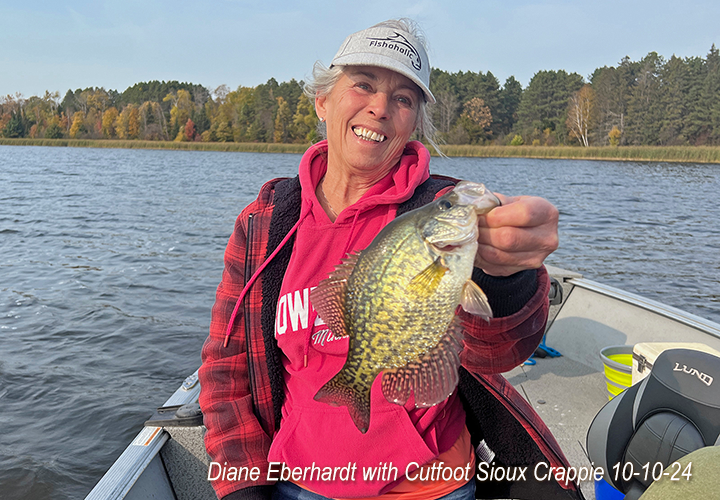 On Little Cutfoot, the water temperature was about 59 degrees. Boat traffic was moderate, maybe 8 to 10 fishing over the more popular areas. Schools of fish were small, and they were scattered, so I opted to skip vertical jigging and troll spinners instead. The standard 3/16-ounce bullet sinker in front of single hook, #3 hammered gold blade spinner and tipped with fatheads worked fine. The action wasn’t fast, but we were able to pick away at crappies long enough to capture 10 of them. Just after 5:00 PM, the action slowed, and it was time to quit anyway, so we settled for the fish we had, and headed home.
On Little Cutfoot, the water temperature was about 59 degrees. Boat traffic was moderate, maybe 8 to 10 fishing over the more popular areas. Schools of fish were small, and they were scattered, so I opted to skip vertical jigging and troll spinners instead. The standard 3/16-ounce bullet sinker in front of single hook, #3 hammered gold blade spinner and tipped with fatheads worked fine. The action wasn’t fast, but we were able to pick away at crappies long enough to capture 10 of them. Just after 5:00 PM, the action slowed, and it was time to quit anyway, so we settled for the fish we had, and headed home.
The fishing action wasn’t so good that I’m in a rush to try Little Cutfoot again. So, I’ll say it this way, if I was staying at a resort on Cutfoot, I’d probably fish Little Cutfoot some more. I don’t think it was good enough to make it a destination though, there are a lot of crappie lakes in the region that offer decent fishing, and with lower levels of boat traffic.
Today marks the beginning of my final week of fishing for the 2024 season. As of now, I’m scheduled to be done on October 17, 2024. I know that MEA weekend can be a popular season ender for some families. So, if you’re planning on heading this way, be sure to check for more fishing updates during the early part of next week. ![]() — Jeff Sundin, The Early Bird Fishing Guide Office Cell Call or Text 218-245-9858 or Email
— Jeff Sundin, The Early Bird Fishing Guide Office Cell Call or Text 218-245-9858 or Email
 October 10, 2024 "Ruling out Rules and Accepting the Exceptions"
October 10, 2024 "Ruling out Rules and Accepting the Exceptions"
![]() The title of today’s report, “Ruling out Rules and Accepting the Exceptions” is particularly timely. Why? Because it pertains both to my fishing trip on Wednesday, and to the reader comments from friend and frequent emailer, Rand Olson. Let’s start first with Rand’s comments, then I’ll work back on my report about yesterday’s fishing trip with Dave and Brett.
The title of today’s report, “Ruling out Rules and Accepting the Exceptions” is particularly timely. Why? Because it pertains both to my fishing trip on Wednesday, and to the reader comments from friend and frequent emailer, Rand Olson. Let’s start first with Rand’s comments, then I’ll work back on my report about yesterday’s fishing trip with Dave and Brett.
In my many years of walleye fishing I’ve been programmed to understand that a walleye’s eyes are extremely sensitive to sunlight, especially on clear lakes. Like many fishermen, I too move toward deeper water under those conditions. Yet, I will have pulled into the dock with my meager livewell, only to find out some of the better fishermen have caught their fish in 6 feet of water on calm, sunny days. Three weeks back, I watched the former Bowen Lodge guide, Jarod do exactly this. He and his crew were pitching jigs to walleyes in 10-1/2 feet of water on a hot, clear, and calm bright sunny day. They had a two-man limit in about 2 hours. He was in water depths I wouldn’t have ever thought of fishing.
As the years pass, I hear many stories along these lines which are exceptions to what I understand to be true. I scratch my head and wonder maybe it’s time to reexamine the original precept of a Walleye’s relationship to sun?”
A) Rand, it’s true that exceptions to commonly held beliefs about fish behavior are common. It’s also true that anecdotal evidence, presented by anglers, often leaves out bits and pieces of the puzzle that are crucial to gaining a full understanding of what goes on under the water’s surface. I will submit that walleye’s find comfort in a wide variety of habitats. If there’s adequate cover, a good food source and favorable water temperatures, they’ll go almost anywhere on a lake, regardless of how shallow or deep the water is.
Often, when discussing the impact of water clarity on walleye fishing, we are not or should not be talking so much about the walleye’s relationship to the water. What we are really talking about, or should be, is their relationship to us, the angler. In clear, calm water, it is harder FOR US to sneak up on walleyes because they become aware of our presence more quickly. Once alerted, they are more difficult to persuade into striking, and our catch rate goes down. The term “boat-shyness” describes the behavior well, the clearer and calmer the water is, the more likely it is that fish will simply wander away from us as we approach. That’s why walleye anglers love a cloudy day with a robust walleye chop on the surface, those conditions provide cover that benefits US the angler.
When water clarity is diminished, for any reason, it makes our task of finding and catching walleyes easier. During the period of time you’ve described, the samecalm and sunny conditions you described help with the development of relatively heavy algae blooms to develop on both Lake Winnie and Cutfoot Sioux. As an observer, my interest in water clarity was piqued during that timeframe and I actually purchased my own Secchi disk and began doing my own periodic testing.
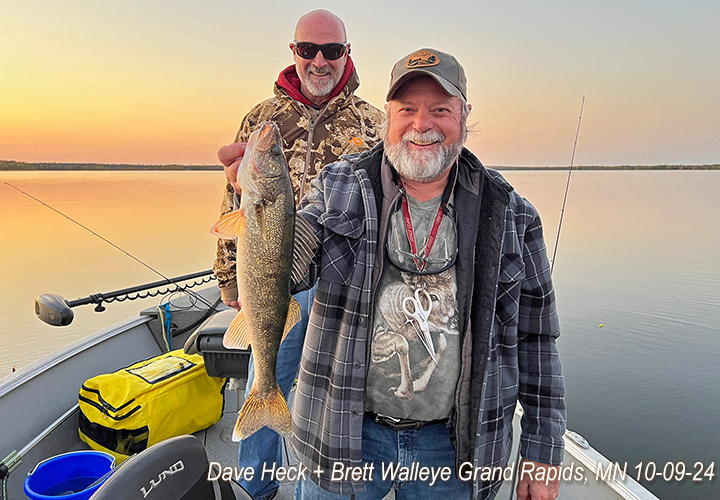 I talked about the Secchi disk readings in my guest post on the Bowen Lodge fishing report page, September 10, 2024. At that time, water clarity on Winnie was 7 feet, a far cry from the reported 27 foot water clarity that made news earlier this summer. I knew at the time that water clarity in Cutfoot was even lower, but did not drop in the disk for an official test of it. Under those conditions, 10 feet of water is not an unreasonable depth for anglers to expect finding and catching walleyes. With that stained water, many of us were also enjoying good fishing in shallower than average water depths. In fact, one of my better days on Winninigoshish occurred on a rock spine in 4 feet of water on a sunny, but breezy day. The experience reminded me of fishing on Winnie during the mid-1980s when heavy algae blooms and stained water conditions were the norm, and not the exception.
I talked about the Secchi disk readings in my guest post on the Bowen Lodge fishing report page, September 10, 2024. At that time, water clarity on Winnie was 7 feet, a far cry from the reported 27 foot water clarity that made news earlier this summer. I knew at the time that water clarity in Cutfoot was even lower, but did not drop in the disk for an official test of it. Under those conditions, 10 feet of water is not an unreasonable depth for anglers to expect finding and catching walleyes. With that stained water, many of us were also enjoying good fishing in shallower than average water depths. In fact, one of my better days on Winninigoshish occurred on a rock spine in 4 feet of water on a sunny, but breezy day. The experience reminded me of fishing on Winnie during the mid-1980s when heavy algae blooms and stained water conditions were the norm, and not the exception.
Another important piece of the puzzle to consider is the use of advanced technology. We both know Jared, the angler you referred to, and I’m confident that he and his fishing partner(s) would have been using FFS on that fishing trip. The forward sonar has been a game changer for many anglers because of how it allows them to detect the presence of fish before getting close enough to alert them. So, on a calm, clear day when walleyes would shy away from anglers who fish without the high tech electronics, anglers who do use the FFS can still sneak up on, and pull some fish out of shallow water.
Other details that we often leave out of discussions about catching fish on a given trip are time of day, seasonal migrations, vegetation, forage, boat traffic and the list goes on. Unless we know every detail about any anglers experiences, it is impossible to state that we know anything as absolute fact. The best we can do is to come up with “working theories” that help guide us through our fishing trips. In my mind, that’s the fun part, whether I catch fish or not, I always learn something.
That brings me to the fishing trip I had with Dave and Brett yesterday. A half day, afternoon charter on a lake that I haven’t fished walleyes on for about 3 months. I knew going in that they were more interested in learning than catching and that helped relieve some of my stress. They knew that I was willing to give it everything I had, which I did, but also that I knew my own limitations, and wasn’t making grandiose promises. As it turned out, the walleye you see pictured here was the only on we caught. Luckily, it was Dave who caught it and under the circumstances, I felt like I had won a battle.
While the catch rate was low, the gathering of knowledge was high. With only a few hours to work with, I hoped for “a lucky break”, which I didn’t really get. But we did a good job of searching around the lake, mostly ruling out places where the fish were not. At the end of the day, I finally came up with a working theory, and if we’d known about it sooner, may have caught more walleyes to prove it.
I’ll tell you more about that trip soon, but I’ve exhausted my time this morning and have to get on the road for work. If you’re headed for the lake, good luck out there, it promises to be another gorgeous day! ![]() — Jeff Sundin, The Early Bird Fishing Guide Office Cell Call or Text 218-245-9858 or Email
— Jeff Sundin, The Early Bird Fishing Guide Office Cell Call or Text 218-245-9858 or Email
 October 9, 2024 "Calmer, Warmer, Brighter Walleye Fishing"
October 9, 2024 "Calmer, Warmer, Brighter Walleye Fishing"
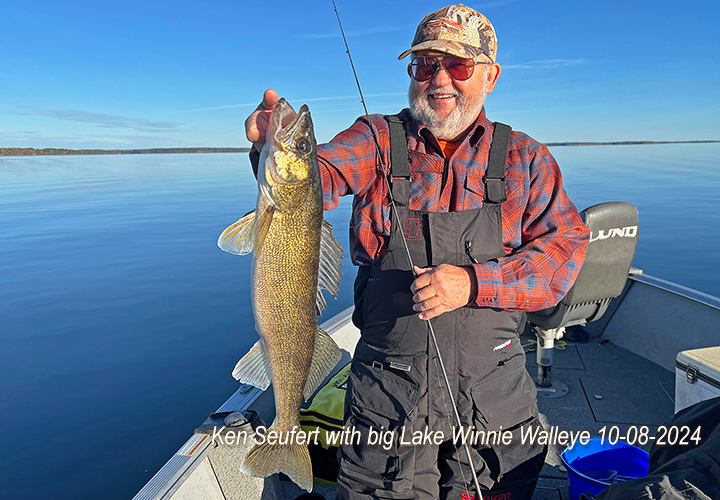 The wind stopped blowing, the sun kept shining and surface water temperatures on Lake Winnie rebounded slightly on Tuesday. Despite frosty temperatures during the wee hours Tuesday morning, the lake water held its own; 55 degrees was the average from 8:00 AM until about 11:00 AM. During midday, temperatures rose into the 58 degree range. A mild, but welcome algae bloom developed on the lake’s calm surface too.
The wind stopped blowing, the sun kept shining and surface water temperatures on Lake Winnie rebounded slightly on Tuesday. Despite frosty temperatures during the wee hours Tuesday morning, the lake water held its own; 55 degrees was the average from 8:00 AM until about 11:00 AM. During midday, temperatures rose into the 58 degree range. A mild, but welcome algae bloom developed on the lake’s calm surface too.
As expected, walleye fishing under these circumstances was not a fast action proposition. That said, it wasn’t bad either, we plodded from spot-to-spot, picking up a fish here and there until we had the fish we wanted. If you’ve been keeping up with recent reports, then you already know how we fished for them. Jigs and minnows, 1/8-ounce sizes in shallow water, and ¼ ounce sizes in deeper water.
Location of fish varied; we caught some in 12 feet of water on the shoreline. There were others holding 18 to 22 feet of water along the edges of both shoreline related breaks, and mid-lake bars. We found one small school of fish right on top of the lake’s main, Bena Bar, in 13 to 15 feet of water too. Fish behavior in all of these locations were similar to the report I offered yesterday; one pass at each spot was the best strategy. Fishing the same spot twice was generally a waste of time.
I won’t say this will be true every day, but on Tuesday, the shoreline related bars were better for me, than were mid-lake spots. Obviously, that could change every day as the weather conditions dictate. I just think it’s a good idea to keep all options open, because the fish do appear to be “on the move”.
Perch fishing, our secondary game plan didn’t work out very well for me. However, it did for some of my friends, they found some good ones in shallow water weeds. The heavier weed patches, wherever you can find them, offered the best action. By the time we’d finished our search for walleyes and landed in the right territory, I had already missed out on the time when the best perch were most active. We caught lots of smaller fish, but keepers had either been caught, moved out of the area, or possibly peaked when a short spurt of breezy conditions encouraged a short feeding spree.
In the October 6, 2024 Fishing Report, I wrote, “I know somebody will correct me if I’m wrong, but the vegetation you see pictured here is Starry Stonewort, I believe.” A reader and sometimes contributor, Bob, did get in touch with a possible tip for identifying Starry Stonewort plants. He wrote, “I believe that if you break an intact stem of Starry, you can squeeze out some gooey greenish liquid from its hollow interior. I’m not aware of any other Minnesota aquatic plant where you can do that.”
Yesterday, we snagged some more of those plants and I tried the squeeze tip. Yes, I did get some gooey green stuff out of the plants, so I guess I’m one step closer to being confident that I have the correct identification.
The walleyes, as you can see in the accompanying photo of Ken Seufert, are still “using” those weeds. The 26-1/2 walleye was holding over the tops of the low-lying plants in about 12 feet of water and struck Ken’s 1/8-ounce glow-perch color Lindy liver bait jig.
If you were on Winnie yesterday morning, you may have seen several larger size groups of loons. In the morning, we saw several “packs” consisting of 20 to 30 birds and they were “cruising” the flats. They appeared to be on some sort of feeding run, that I’ve never observed before. After a half hour or so, they disappeared from the shoreline flat and turned up later, out in the middle of the lake. I’m not sure how we could confirm a connection, but it seemed to me that when those loons were feeding on the flats, the fish were biting too. When the biords disappeared, we stopped catching fish there and that’s when I move into deeper water.
I don’t suppose anyone wants to offer some information about this?
Last week, in the October 4, 2024 Crappie Fishing Report about the day the Hippie Chick and I went Crappie fishing, I wrote, “We saw and had a quick chat with some friendly guys fishing nearby, and I think that they may have been fishing that way. They didn’t say so, but it appeared to me that they were drifting and using a slower presentation.”
Well, I got a text from Steve, one member of that group and a separate email from Lynn, another angler in that boat. Both accounts were similar, Steve’s was the most detailed and he wrote, “Hi Jeff, I am one of the “friendly fishermen” that greeted you and the Hippie Chick on the lake the other morning. In your post you stated that we (appeared to be) fishing slowly and probably fishing with jigs, and yes we were. We were using both live bait and an assortment of plastics, best results that morning were with minnows. Thanks again for your work, we really enjoy and appreciate your reports on fishing in the Grand Rapids area.
Looked to us like Hippie Chick was putting a few more fish in the boat than the guide, good for her! Keep up the good work.”
Thank you both Steve, and Lynn too. Yes, in a perfect world, everybody who fishes in my boat would catch all the fish and I could just tie knots and steer the boat. That day it worked, Susan was definitely catching more fish than me, just the way I like it. ![]() — Jeff Sundin, The Early Bird Fishing Guide Office Cell Call or Text 218-245-9858 or Email
— Jeff Sundin, The Early Bird Fishing Guide Office Cell Call or Text 218-245-9858 or Email
You Are Invited To Become A Duly Deputized Fishrapper Cub Reporter Too!
 If you've been waiting for a gold engraved invitation to participate in the daily reports, then stop waiting and consider this your own personal invitation.
If you've been waiting for a gold engraved invitation to participate in the daily reports, then stop waiting and consider this your own personal invitation.
Helping your fellow fishermen and women stay abreast of fishing conditions in your area is good for everybody and it's easier than you think! You don't have to write a book, you don't have to share your secret fishing spots and you don't even have to mention your lake. But even a few words about general trends, seasonal patterns and local weather conditions can really help.
Be like me, become a duly deputized "Cub Reporter", it's good for fishing! Contact Us or if you prefer to be "social", Fishing Reports Minnesota, the Facebook counterpart to this page is open to the public, so you can post your own fishing update or just share a photo of a nice catch.
 Wired2Fish October 9, 2024 "Why Brown Trout are the Coolest Fish I’ve Ever Caught"
Wired2Fish October 9, 2024 "Why Brown Trout are the Coolest Fish I’ve Ever Caught"
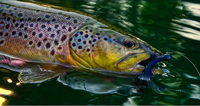 "While there are a multitude of game fish species to pursue in North America and around the world, very few offer the opportunity to stalk predator fish in small windows on a small number of rivers. Brown trout sit atop the food chain as the apex predator on a handful of streams and rivers across the country. Coupled with their finicky nature and small low-light feeding windows, they can be tough to catch in a lot of systems. But that is also where the thrill comes for anglers like me. And it’s why I consider the brown trout the coolest fish I’ve ever caught.
"While there are a multitude of game fish species to pursue in North America and around the world, very few offer the opportunity to stalk predator fish in small windows on a small number of rivers. Brown trout sit atop the food chain as the apex predator on a handful of streams and rivers across the country. Coupled with their finicky nature and small low-light feeding windows, they can be tough to catch in a lot of systems. But that is also where the thrill comes for anglers like me. And it’s why I consider the brown trout the coolest fish I’ve ever caught.
Don’t get me wrong. I love to fish for fish that are plentiful and dumb too. I spent most of four decades catching bass all over the country. As well as just about every other freshwater species of fish and a good many saltwater fish. I love a good day of fishing action, regardless of the species. But the thrill in fishing for me has always been the exploration and ..." Learn More >> Why Brown Trout are the Coolest Fish I’ve Ever Caught
 Lake of the Woods, LOW Tourism October 9, 2024
Lake of the Woods, LOW Tourism October 9, 2024
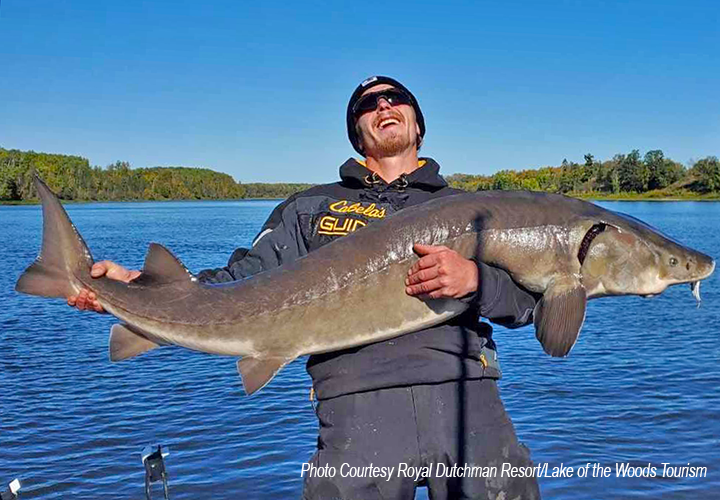 "Sturgeon fishing is really picking up as the water cools in the Rainy River. Sturgeon are not legal to harvest at this time, but catch and release is allowed. From now into the month of April, 2025 fishing for sturgeon will continue to be catch and release only, until the "keep season" begins again, anglers can then choose, if they catch one, to harvest 1 legal fish drung the 2025 season.
"Sturgeon fishing is really picking up as the water cools in the Rainy River. Sturgeon are not legal to harvest at this time, but catch and release is allowed. From now into the month of April, 2025 fishing for sturgeon will continue to be catch and release only, until the "keep season" begins again, anglers can then choose, if they catch one, to harvest 1 legal fish drung the 2025 season.
Walleye fishing on the Rainy River continues to get better and better. There are definitely more shiners and walleyes in the river this week. Good fish are being caught in many sections of the river. Trolling crankbaits in the fall is a well known strategy to catch hungry walleyes chasing shiners. Trolling is also a great way to cover water, get that reaction strike and find areas where fish are most concentrated.
The river is not only a great option for small boats if it is windy, but also offers more variety. There are some nice crappies, pike and smallmouth bass in the mix for fall anglers who were fishing the Rainy River this week.
On the South End of Lake of the Woods, walleye and sauger fishing remains excellent, with numbers of walleyes and saugers being caught. The fall bite is definitely on. Anglers are finding fish a bit shallower this week, ranging from 20 to 25 feet across the south shore of Lake of the Woods. Areas across the south shore including the Lighthouse Gap (where the Rainy River enters Lake of the Woods) west to the Morris Point area, west to Zippel Bay area to Long Point are all still producing nice fish.
Jigging with frozen, or live emerald shiners, is catching most of the fish. Locating fish on your sonar and anchoring up for about 30 minutes will normally give you a good idea of what is living in the area and a good strategy. Successful jig colors in the stained waters of LOW are gold, glow white, glow red, chartreuse, orange, and pink. Gold combined with any one of these colors is often a good choice.
Fishing is flat out excellent up at the Northwest Angle. Some anglers are fishing the Minnesota side, others the fishing on the Ontario side. Walleyes are using a variety of areas, but structure such as points and neck down areas with some current are good right now. A mixed bag of fish is the norm in these parts. Walleyes, saugers, jumbo perch, crappies, pike, smallmouth bass and muskies are all being caught. Fall fishing leading into early ice is some of the best fishing of the year and a beautiful time to be out." — Lake of the Woods Tourism, (800) 382-FISH
 October 8, 2024 "Let's Clear Something Up; Lake Winnibigoshish!"
October 8, 2024 "Let's Clear Something Up; Lake Winnibigoshish!"
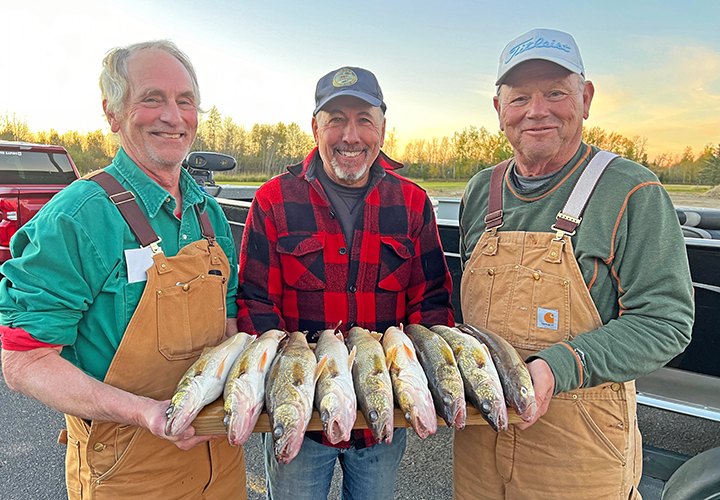 A week ago, I would have guessed that both water temperatures, and water clarity in Lake Winnibigoshish would have remained favorable to anglers for at least another week. Mother Nature though, had other plans and dished out a brutally forceful and cold west wind on Sunday. On Tuesday, in the aftermath of that cold front, surface water temperatures had fallen from 64 degree down to just 56 degrees. My Secchi disk reading on Winnie’s west side Tuesday was now 13 feet, a 6-foot increase in water clarity in only 4 short days.
A week ago, I would have guessed that both water temperatures, and water clarity in Lake Winnibigoshish would have remained favorable to anglers for at least another week. Mother Nature though, had other plans and dished out a brutally forceful and cold west wind on Sunday. On Tuesday, in the aftermath of that cold front, surface water temperatures had fallen from 64 degree down to just 56 degrees. My Secchi disk reading on Winnie’s west side Tuesday was now 13 feet, a 6-foot increase in water clarity in only 4 short days.
Walleyes that had previously inhabited shoreline breaks in relatively shallow water fled the scene and turned up deeper, in 19 to 24 feet of water. We found them on both shoreline related breaklines, and on some of the largest mid-lake bars. Their attitude was generally positive, and when we could see them, they usually struck. Boat shyness, an issue we haven’t faced for a while now, reared its ugly head though, and almost every spot we fished turned out to be a “one pass wonder”. The typical scenario was for us to stop at a spot, catch 1 or 2 fish almost immediately, and then watch the screen go blank. Once the fish knew we were on top of them, they wandered away in favor of better privacy.
The first lucky break for me was that the tiny packs of fish were widespread along the edges of the bars. For a time, every single stop we made produced a fish or two. So, slowly but surely as we leap-frogged along the edges of the bars, the livewell filled up. That plan held up for us until about 1:30 or so when the northwest wind increased in speed, and my boat control suffered. Drifting was too fast, and backtrolling was too wet and I was forced back toward the western shoreline.
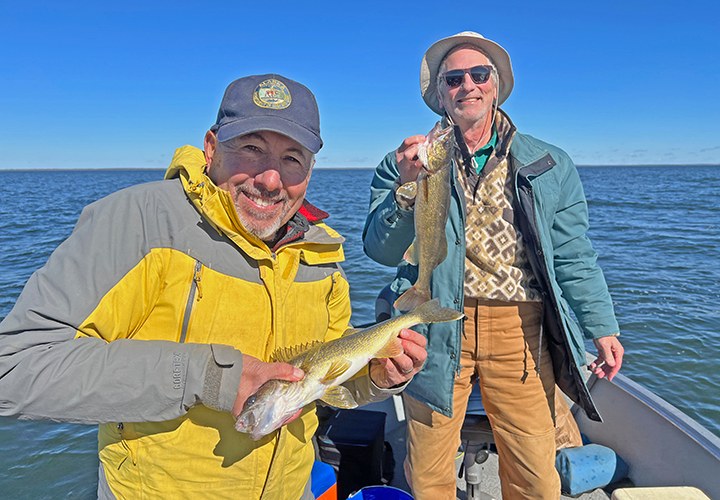 My second lucky break of the day came in the form of a single school of fish, maybe a dozen or so, that were holding on a 12-foot-deep point. Those fish struck on the first drift, and some of them struck again on the second drift. After fishing that spot, we’d amassed a total of 16 walleyes, 2 short of my crew’s 3 man limit, but impressive under the circumstances.
My second lucky break of the day came in the form of a single school of fish, maybe a dozen or so, that were holding on a 12-foot-deep point. Those fish struck on the first drift, and some of them struck again on the second drift. After fishing that spot, we’d amassed a total of 16 walleyes, 2 short of my crew’s 3 man limit, but impressive under the circumstances.
Along the way, we boated another 10 or 12 fish that were in the protected slot, many of them just barely. Impressive too was the average size of the “keepers” that were caught. Because of the strong 2018- and 2019-year classes of walleyes, fish ranging in size from 17 to 19 inches are relatively plentiful. I’d say that there are about as many fish measuring just over the 18-inch threshold as there are measuring just under it. So, I suggest making sure that every fish you catch gets put on the ruler.
Presentation was simple, ¼ ounce live bait jigs tipped with assorted minnows from the Fred’s Bait “River Mix”. There are some golden shiners, some rainbows, a few larger size fatheads and other assorted minnows in the mix. They all seemed to work, but I was not too confident about the larger size golden shiners, the fish seemed to prefer smaller minnows than those yesterday. The only time we used lighter, 1/8 ounce jig heads was when we fished one small patch of weeds in 13 feet of water. There, the ¼ ounce size was too heavy, and our hooks were fouled too quickly for effective fishing. In that weed patch, there were some pike, and a handful of perch, but no walleyes.
Another interesting change on Tuesday was the widespread disappearance of weeds in certain wind-blown areas. Sunday’s strong west winds blew a lot of them off of the flats completely, we could see some of them still drifting around in the water. Because many of the weeds are gone, baitfish are liable not to return, and locating fish in the shallows will probably be more hit and miss now than before.
I was really happy that our day ended well, especially because I was fishing with some of my oldest and most valued friends. That said, I feel like a lot of our success was attributable to luck. The only reason I started checking out the mid-lake bars was because my little voice was nagging me. If I’d have ignored that, and had stuck with areas where the fish were located a few days ago, it would have been a struggle; I think.
Today, I’ll find out how reliable, if at all, the pattern is. I’ll be back out there, this time with calm seas and sunny skies on the heels of a frosty dawn. If anything, the water will be even cooler and clearer today. I’ll let you know how it works out tomorrow morning. OH, and speaking about tomorrow morning(s), there will be about 9 more of them; that’s how many workdays I have left on my calendar. After that, I’m going to take a little time off to go hunting. ![]() — Jeff Sundin, The Early Bird Fishing Guide Office Cell Call or Text 218-245-9858 or Email
— Jeff Sundin, The Early Bird Fishing Guide Office Cell Call or Text 218-245-9858 or Email
 Brainerd MN Area Fishing Report October 7, 2024
Brainerd MN Area Fishing Report October 7, 2024
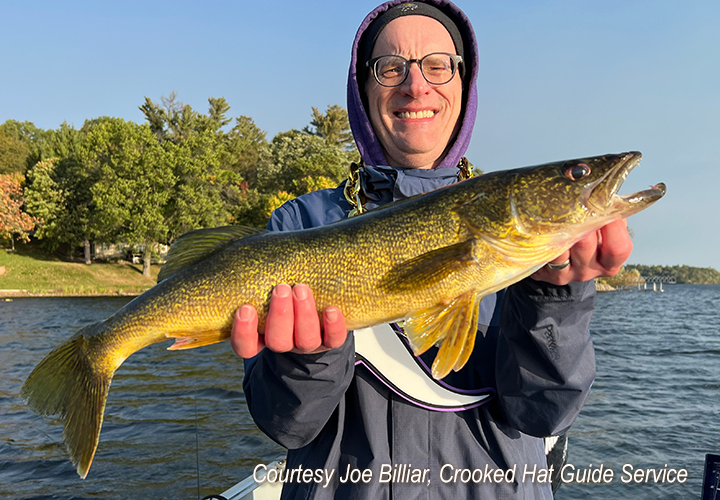 "In the Brainerd area it went from feeling like summer was still here to full blown fall in just a couple days. Water temps have dropped drastically hovering around 60-63 degrees. With the strong winds this week fishing was difficult and less than ideal.
"In the Brainerd area it went from feeling like summer was still here to full blown fall in just a couple days. Water temps have dropped drastically hovering around 60-63 degrees. With the strong winds this week fishing was difficult and less than ideal.
Sticking to small lakes was the most productive for the group in my boat this weekend. Looking at the graphs showed tons of bait just outside the weed edge and off the second break. Working 1/4 ounce jigs tipped with either shiners or sucker minnows elicited the majority of the bites.
Working slow and picking through spots while paying close attention to side image outside weed edges produced pike, bass, and walleye. Side image was as important if not more important than live image with the large cold front. Live image is great but when fish are belly to bottom they can be hard, if not impossible, to see on live image. These fish will still show on side scan where I could not locate them live image.
Walleyes found off the second break can be targeted with Lindy rigs but were very boat shy and didn’t let us sit on them for long. The walleyes in the weeds were very difficult to see but are more willing to bite when large swings in the weather occur. If an area produces, stopping and slowing down over the spot will produce a few more bites for fish that cannot be seen on graphs. The walleyes are taking their time eating larger minnows so make sure to give it slightly longer before setting the hook or you can find yourself with half a minnow like we had happen more than a few times.
As the weather cools I will be out searching for big walleyes and begin chasing musky with large suckers. With the warmer year I will be running until ice up and pushing late into the season. Good luck and tight lines this week." — Joe Billiar, Crooked Hat Guide Service
 Ely Area, Arrowhead Outdoors Fishing Report October 7, 2024
Ely Area, Arrowhead Outdoors Fishing Report October 7, 2024
 "Walleye - Heavy winds this last week had many anglers laying low. Anglers that went out fishing found active walleyes in 15-20 feet of water around wind blown points and sunken islands. Small and medium sized suckers were the hot baits. Anglers fished them on a lindy rig or 1/4-3/8oz jig. Gold, blue/white and pink/white were the hot colors this last week. Water temps are now in the mid to high 50's.
"Walleye - Heavy winds this last week had many anglers laying low. Anglers that went out fishing found active walleyes in 15-20 feet of water around wind blown points and sunken islands. Small and medium sized suckers were the hot baits. Anglers fished them on a lindy rig or 1/4-3/8oz jig. Gold, blue/white and pink/white were the hot colors this last week. Water temps are now in the mid to high 50's.
Smallmouth - Smallies continue to binge feed on anything they can get in their mouths. Large and medium size suckers have been the best way to avoid catching piles of 2-3lb bass. Lindy rigs and jigs have been the best way to fish large minnows. Sunken islands that top out in 10-15ft of water have been the best areas to find smallies. Not all humps are created equal, so if the bass aren't biting on the hump your fishing, keep moving!
Crappies - Multiple anglers have been reporting that the crappies have started to school up and are sliding down to warmer, stable water temperatures. Anglers should now be focusing their efforts in the 12-16ft of water range. Jig/twister, beetle spins, and the classic crappie minnow and bobber have been catching crappies. Anglers have been finding crappies just off weedbeds and around sunken islands.
Pike - Pike activity has increased again this last week as cooler water temps have arrived. Large suckers, fished under a bobber, large minnow bait and large soft plastic minnow baits have been deadly this last week. Big pike are starting to set up on major points, shallow rocky flats and river mouths as they wait for fall spawning ciscos and whitefish to arrive. Anglers looking for that trophy pike should be focusing their efforts in these areas.
Stream Trout - Clearly, as cooler temps start to cool off the water, stream trout fishing is only going to get better and better. Rainbow trout continue to get the bulk of anglers' attention. Trolling cowbells, with small crankbaits, over deep water continues to be the most effective way for boat anglers to find and catch rainbows. Brook trout have started to show up in angler reports too now. Anglers have been finding them suspended over deep water yet, but as water temps drop, brookies will move up shallow." — Arrowhead Outdoors, 218-365-5358
 October 6, 2024 "Lake Winnie Fishing Update"
October 6, 2024 "Lake Winnie Fishing Update"
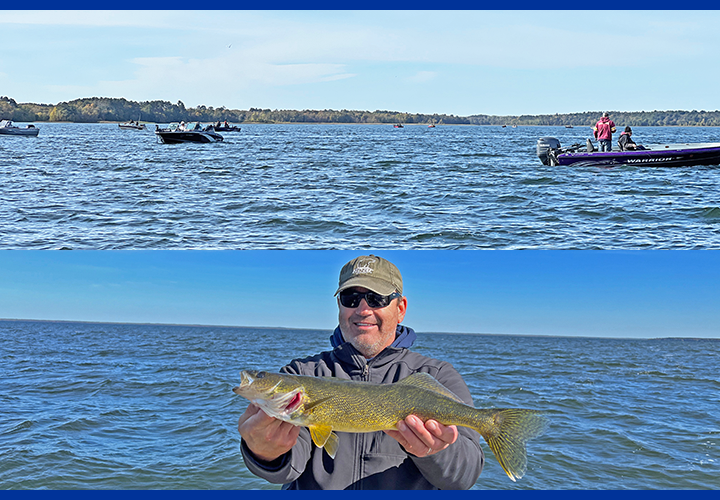 The hurricane season isn’t over yet, and as long as they keep brewing, the unsettled weather keeps coming to the northland. Lately, the winds either blow at 20 MPH from the south, or 30 MPH from the west. Whenever they’re not doing that, they’re not blowing at all, and the lakes go flat. Take the current forecast for my upcoming trip with Ken Seufert as an example, we’re fishing today, and then again on Tuesday. NOAA, Sunday: “High near 54. Breezy, with a northwest wind of 15 to 20 mph, with gusts as high as 40 mph.” Tuesday: “Patchy frost before 8am. Otherwise, sunny, with a high near 64. Calm wind.”
The hurricane season isn’t over yet, and as long as they keep brewing, the unsettled weather keeps coming to the northland. Lately, the winds either blow at 20 MPH from the south, or 30 MPH from the west. Whenever they’re not doing that, they’re not blowing at all, and the lakes go flat. Take the current forecast for my upcoming trip with Ken Seufert as an example, we’re fishing today, and then again on Tuesday. NOAA, Sunday: “High near 54. Breezy, with a northwest wind of 15 to 20 mph, with gusts as high as 40 mph.” Tuesday: “Patchy frost before 8am. Otherwise, sunny, with a high near 64. Calm wind.”
Lucky for me, the northwest wind is easier to deal with than some of the other wind directions. So, I should be able to find a place to hide from the worst of it today, hopefully on the west side of Lake Winnie.
There was a halfway decent mixed bag bite over there last Friday when I fished with the Goettl crew. That day, we launched the boat at Richard’s Townsite, and I was amazed at the boat traffic at the ramp. There were dozens of rigs, the parking lot was full and there were trucks with boat trailers parked along the roadside for another block. Because I was off yesterday for my granddaughter’s birthday party, I can’t say if the traffic was that heavy, but either way, what we experienced on Friday was likely the peak of traffic for this season.
The surface water on Winnie, as of Friday morning, was about 61 degrees, give or take. Because of the strong winds, the water was mixed thoroughly, and the temperatures were uniform every place I stopped and was the same from the beginning to the end of our day. We could see that water clarity has increased somewhat, but with the turbulent conditions, I could not get accurate Secchi disk reading. If conditions allow, I will check that again today and include it in tomorrow’s report.
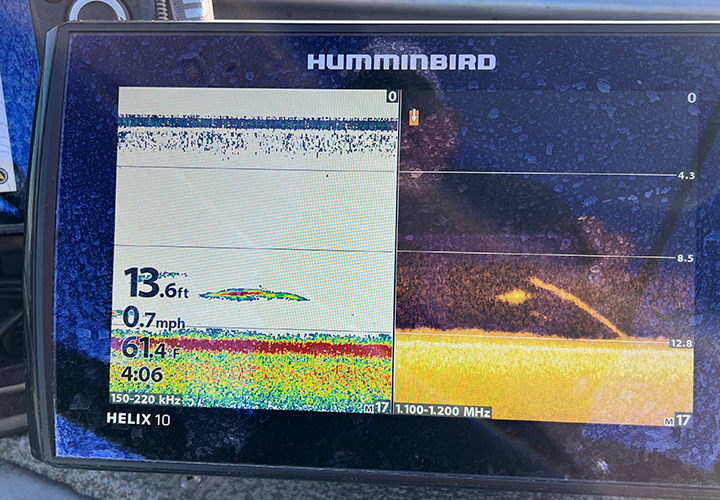 Walleye was the focus of my trip on Friday, So, I did everything possible to avoid fishing on the southwestern shoreline. For one thing, that’s where the largest crowds were fishing, and I wanted to avoid the traffic. Second, there have been lots of northern pike hitting along that western shoreline, and my Friday crew typically shows little to no interest in catching them. Recently, I’ve been able to catch some walleye, with few other species mixed in by fishing mid-lake structure. To an extent, that plan was working on Friday, albeit not quickly.
Walleye was the focus of my trip on Friday, So, I did everything possible to avoid fishing on the southwestern shoreline. For one thing, that’s where the largest crowds were fishing, and I wanted to avoid the traffic. Second, there have been lots of northern pike hitting along that western shoreline, and my Friday crew typically shows little to no interest in catching them. Recently, I’ve been able to catch some walleye, with few other species mixed in by fishing mid-lake structure. To an extent, that plan was working on Friday, albeit not quickly.
We were picking off one fish at a time by using ¼ to 3/8-ounce jig and minnow combos in 16 to 22 feet of water. I never marked any large schools of fish, and the rule of thumb was catching 1 or 2 fish at each stop. Of the fish we caught, the ratio of “slot-fish” to Keepers was about 1 to 1. So, by the time we’d caught a dozen fish, we had 6 in the livewell. If conditions had been comfortable, I would have continued with that plan, but with 3-foot whitecaps, nobody was enthusiastic about staying out there. Moving toward the shoreline became the better choice, even if I had to give up on the pure play for walleyes.
The trip from Moses Bar to the western shoreline was bumpy, but as we got closer, we could see calmer water. We could also see a line of boats, all focusing on the same breakline that we’d be fishing. Presumably, most of the people there were in pursuit of yellow perch, at least those were the reports I’d been getting from friends. But we could see folks landing larger fish too, most of them pike, but with a random walleye in the mix as well. The chatter from some fellow guides was that the perch were coming from 12 feet of water. By the time I arrived, my scope revealed fish in somewhat deeper, 13-1/2 foot water.
The perch bite, from what I could find had ended and the pecking order had switched to larger fish. As expected, northern pike were the dominant predator, but there were some walleyes in the mix. There were enough of them to keep us interested, and that made putting up with the pike more palatable. That said, I burned through a lot of jigs in those few hours, pike bite offs occurred frequently.
When they struck, the walleyes came in at about a 2:1 ratio of protected slot fish to keepers. By the time we’d caught another dozen or so, we’d only built the larder up to 10 keepers. We did bag a few keeper perch, and they were nice ones, but the morning crowds apparently got in on a much better perch bite than we did. Time was in short supply now, and I’d had all the pike I could handle, so I moved east to try on last spot, a slow tapering point in 12 feet of water. On that point, I graphed a small school of fish and Chris picked off a keeper. I made a second pass, and this time Phil picked up another keeper. With 12 walleyes in the livewell, we called it a day.
 I know somebody will correct me if I’m wrong, but the vegetation you see pictured here is Starry Stonewort, I believe. A couple of years ago, not far from the same location, there were a lot of fish holding over the tops of the same plants. At that time, I mentioned it to a friend at the DNR. “It seems like the fish really like that vegetation”, I commented. “Well, it is an invasive weed species and because of that, we don’t use the term LIKE IT. However, it does appear that fish do use it, either for cover, or to feed on forage species that use it for cover,” he responded.
I know somebody will correct me if I’m wrong, but the vegetation you see pictured here is Starry Stonewort, I believe. A couple of years ago, not far from the same location, there were a lot of fish holding over the tops of the same plants. At that time, I mentioned it to a friend at the DNR. “It seems like the fish really like that vegetation”, I commented. “Well, it is an invasive weed species and because of that, we don’t use the term LIKE IT. However, it does appear that fish do use it, either for cover, or to feed on forage species that use it for cover,” he responded.
Whether or not the plants shown in my photo are Starry Stonewort or not, the fish definitely are “USING IT.” Whenever I see that fuzzy stuff growing along the lake bottom, I can graph fish over the tops of it. On Friday, places along that same shoreline where I could not see that low lying vegetation on my graph, were also void of fish.
Depending on the wind today, I may get to check it out again and if so, I’ll get more detailed pictures. Right now, I’m up against the clock and have to run. If you’re headed for the lake today, be careful, and stay on the calm side! ![]() — Jeff Sundin, The Early Bird Fishing Guide Office Cell Call or Text 218-245-9858 or Email
— Jeff Sundin, The Early Bird Fishing Guide Office Cell Call or Text 218-245-9858 or Email
 October 4, 2024 "The Hippier Fall Crappie Fishing Update"
October 4, 2024 "The Hippier Fall Crappie Fishing Update"
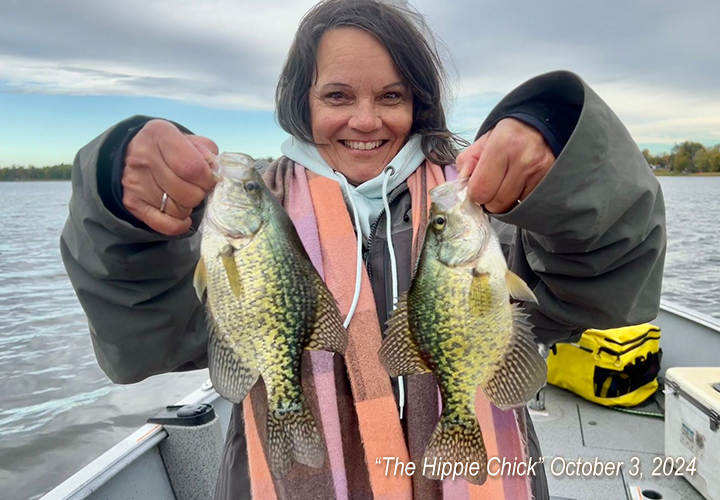 Cancellations aren’t a lot of fun for me, especially when the happen in the middle of primetime fishing seasons like the one we’re in right now. There are times when they can’t be avoided though, and when they do happen, I try to catch up on chores, fix my broken stuff and the like. Sometimes, when I’m lucky, the Hippie Chick’s schedule has an open space, and we can take time for our own fishing date; that’s what we did yesterday.
Cancellations aren’t a lot of fun for me, especially when the happen in the middle of primetime fishing seasons like the one we’re in right now. There are times when they can’t be avoided though, and when they do happen, I try to catch up on chores, fix my broken stuff and the like. Sometimes, when I’m lucky, the Hippie Chick’s schedule has an open space, and we can take time for our own fishing date; that’s what we did yesterday.
She’s been following the fishing reports lately, so when I asked her out for a fishing date, her response was somewhat predictable. “Can we go crappie fishing?” “Sure honey, if that’s what you want to do, we’ll go crappie fishing “, I said. So, when the morning came, we loaded up the boat, and headed for our 2nd favorite “date lake”, not far from home.
At the landing, surface water temperatures had fallen to 61 degrees in shallow water, 62.5 degrees when we crossed the breakline into 8 feet of water. The sky was grey, and there was a light chop on the water, and it seemed like fish on the weed edges should be active. We started trolling spinners, hers tipped with a minnow, and mine tipped with a night crawler to help search for walleyes or maybe sunfish. We kept that up for half an hour, but not much happened in the shallows.
 Maybe they’ve moved out of the weeds, I thought. So, I started on our way to one of the lake’s deeper, mid-lake holes, a 21-to-23-foot depression. Along the way to that stop, I started seeing scattered singles, doubles hugging the bottom on the flats. That pattern was fresh in my mind because of a trip with the Reynolds last week to a different lake. (See report September , 2024)
Maybe they’ve moved out of the weeds, I thought. So, I started on our way to one of the lake’s deeper, mid-lake holes, a 21-to-23-foot depression. Along the way to that stop, I started seeing scattered singles, doubles hugging the bottom on the flats. That pattern was fresh in my mind because of a trip with the Reynolds last week to a different lake. (See report September , 2024)
Okay sweetie, I’m gonna add extra weight to your spinner, and we’ll try trolling right here, I explained. “The water is about 17 feet deep, so we’ll cast them out farther than we do in the weeds”, I added. The #4 split shot, placed behind the original 3/16-ounce bullet sinker turned out to be just right. I cast Susan’s spinner into the water, started trolling and then started rigging mine. Before I began fishing, she already had a crappie on her line. By the time I started fishing, she’d caught another one, and it wasn’t long before we had our first “double”. That area was fun because we had plenty of action, but most of those fish were small and I didn’t want to keep fishing there.
Next, I started roaming around on the flat in search of a few larger fish. The action was much slower now, but when I spotted fish, they usually struck. These fish were not monsters, but they were better suited to our needs, ranging in size between 10 and 11 inches, so we stuck with that program for a while.
Zoom in here on the screenshot of our trolling pattern. You see that tflat we fished over lies adjacent to the deeper hole, and that most of the crappies were riding well above the upper edges of the breakline. There were some fish along that breakline too, holding along the edges in about 20 feet of water. It wouldn’t surprise me if soon, most of the fish from the flat join those fish along that deeper water breakline and eventually move out over the center of the hole.
There were times when I considered switching our presentation to jigs and minnows. But we were already having fun, and there wasn’t much incentive for experimentation. We saw and had a quick chat with some friendly guys fishing nearby, and I think that they may have been fishing that way. They didn’t say so, but it appeared to me that they were drifting and using a slower presentation. Whether it was jigs they were using or some alternative presentation, it was working. We could see, even from a distance, that they too were catching plenty of fish. Maybe they’ll drop us a line with an update, and if they do, I’ll let you know.
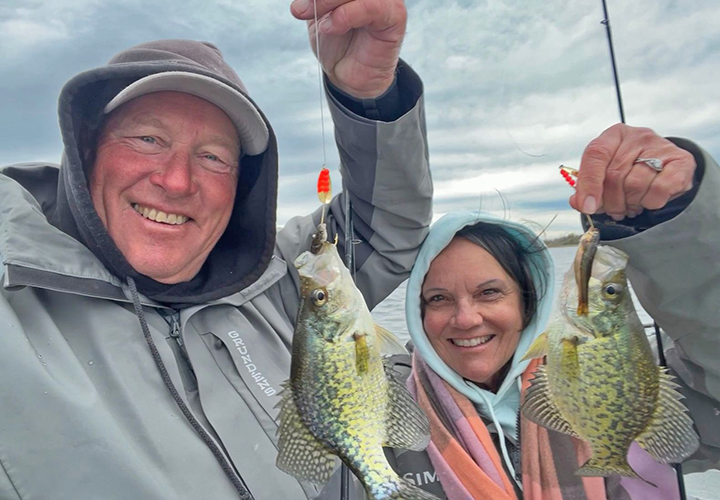 As you can also see by the screen image of my Humminbird, The cold air temperatures continued downward pressure on the surface water. We started fishing when it was 62.5 degrees, and by noon, it had fallen to 61 degrees. It's likely that the exodus from weeds will continue and that in most lakes, crappies will cintinue moving deeper. So, on a serious note, the situation we encountered is exactly why I try to select shallow water lakes for crappie fishing in the fall. With a maximum depth of about 23 feet, it’s far less likely that barotrauma will be an issue. If we try a lake, and the fish are running small, we don’t risk killing a bunch of them by releasing them after they’ve been damaged.
As you can also see by the screen image of my Humminbird, The cold air temperatures continued downward pressure on the surface water. We started fishing when it was 62.5 degrees, and by noon, it had fallen to 61 degrees. It's likely that the exodus from weeds will continue and that in most lakes, crappies will cintinue moving deeper. So, on a serious note, the situation we encountered is exactly why I try to select shallow water lakes for crappie fishing in the fall. With a maximum depth of about 23 feet, it’s far less likely that barotrauma will be an issue. If we try a lake, and the fish are running small, we don’t risk killing a bunch of them by releasing them after they’ve been damaged.
The subject of barotrauma has gained a lot of traction recently, so I won’t spend a ton of time on it this fall. But I will give you my annual “sales pitch” about fishing for panfish in deep water. If you are forced to do it, for whatever reason, set the number of fish you would like to harvest, catch them, and then move onto something else.
I doubt that I’ll be back at that lake anytime this fall because most of the fish were smaller than my customers will approve of. But I'll be searching for more shallow lakes to try and wherever I do go, I'll be trying not to fish deeper than is absolutely necessary to complete whatever mission I'm on at the time.
For the Hippie Chick and me, the mission doesn't always have to be a big one. Filling the livewell isn’t a goal and neither is catching the maximum number of fish. For us, having a good time IS the goal and yesterday, we’d already done that early in the day. So, with 5 “keeper” fish in our livewell for supper, and the effects of chilly fingers nagging us for our attention, we decided to head for the comforts of home. ![]() — Jeff Sundin, The Early Bird Fishing Guide Office Cell Call or Text 218-245-9858 or Email
— Jeff Sundin, The Early Bird Fishing Guide Office Cell Call or Text 218-245-9858 or Email
 Wired2Fish October 3, 2024 "Bringing Back the Spinnerbait for Fall Bass"
Wired2Fish October 3, 2024 "Bringing Back the Spinnerbait for Fall Bass"
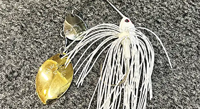 "The spinnerbait is a lure that many bass anglers first began throwing at a young age as it is versatile, easy to cast, snag-resistant and most importantly, it catches bass.
"The spinnerbait is a lure that many bass anglers first began throwing at a young age as it is versatile, easy to cast, snag-resistant and most importantly, it catches bass.
Some anglers leave the spinnerbait by the wayside as they progress along their fishing journey. But others (Jason Christie, cough, cough) understand its incredible potential and have embraced the spinnerbait.
These anglers realize that each spinnerbait is different, and identifying the strengths of each can help you catch more fish. There are numerous ways a spinnerbait can be customized to the conditions an angler is presented with on the water. Breaking the design elements can help understand what makes each work in a given situation ..." Learn More >> Bringing Back the Spinnerbait for Fall Bass
 October 2, 2024 "Falling Into Fall, Happily!"
October 2, 2024 "Falling Into Fall, Happily!"
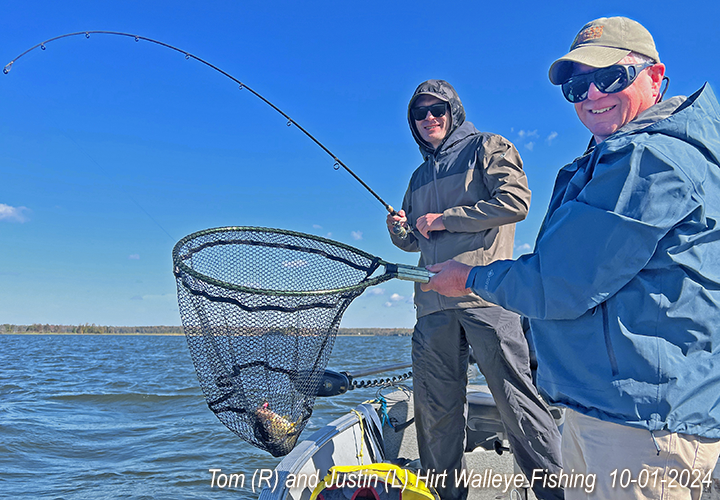 Fall fell over north central Minnesota overnight Monday, and into Tuesday. Air temperatures were chilly, dropping into the mid-40s, but still not cold enough to produce our first frost. The northwest wind rolled the surface water into whitecaps, forcing water temperatures downward. On the lake we fished, 63 degrees was the day-long reading on my screen. The day before that, on Lake Winnibigoshish, 66 to 67 degrees was still the dominant temperature reading. I imagine that there too, surface readings were likely decreased.
Fall fell over north central Minnesota overnight Monday, and into Tuesday. Air temperatures were chilly, dropping into the mid-40s, but still not cold enough to produce our first frost. The northwest wind rolled the surface water into whitecaps, forcing water temperatures downward. On the lake we fished, 63 degrees was the day-long reading on my screen. The day before that, on Lake Winnibigoshish, 66 to 67 degrees was still the dominant temperature reading. I imagine that there too, surface readings were likely decreased.
For me, fishing with first time customers Tom and Justin Hirt, the day, chilly conditions included, was a gift. “We do well fishing for panfish, but we’re not really walleye fishermen. Tom said. “We love eating fish, but we’re not just in this for limits of walleyes, we’re here to learn how to fish for, and hopefully, catch some walleyes,” he added.
Now if you’re Jeff Sundin, these words are like handing the gate keeper your key that unlocks the door to the magic kingdom. It’s exactly the sort of fishing charter that I love doing, fishing with folks, inexperienced or not, who are on a mission to move higher on the learning curve.
When we motored out onto the lake, the air was chilly. For the first time this season, my fingers tingled, my hood was pulled up tight over my head and I wished I had a heavier coat to wear. So, we didn’t travel far to make our first stop. A small, free standing weed and gravel bar that tops out at about 8 feet deep. I handed the crew jigging rods rigged with 1/8 live bait jigs and offered advice about my favorite way to put minnows on their hooks. We tossed our lures into the water, and I started on our first drift along the breakline.
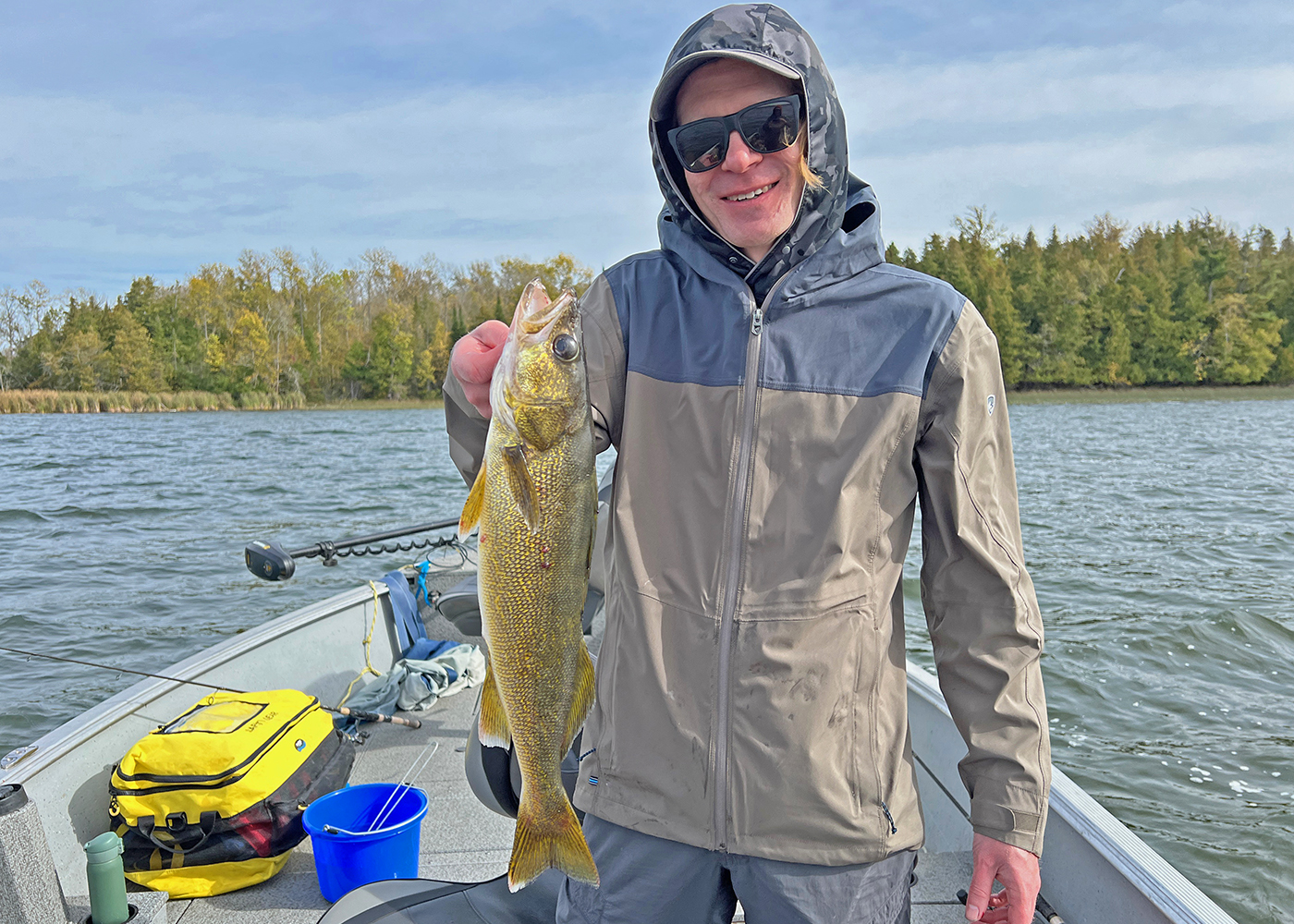 Ironically, we started getting bites right away, but the fish acted like they were chilly too. My first 3 or 4 attempts to demonstrate how to set the hook all ended badly, not a single fish stayed on the hook long enough for us to see what they were. My crew was chuckling, I imagine they were thinking to themselves, “if the big-time pro is having trouble catching them, we won’t look too bad.” They were right about that, their techniques didn’t look bad at all, I saw lots of potential. Now I just needed to find some “catch-able” fish to practice on.
Ironically, we started getting bites right away, but the fish acted like they were chilly too. My first 3 or 4 attempts to demonstrate how to set the hook all ended badly, not a single fish stayed on the hook long enough for us to see what they were. My crew was chuckling, I imagine they were thinking to themselves, “if the big-time pro is having trouble catching them, we won’t look too bad.” They were right about that, their techniques didn’t look bad at all, I saw lots of potential. Now I just needed to find some “catch-able” fish to practice on.
The rest of the day would remind you of following your mail carrier on a workday. Go to a stop, get a strike or 2, catch a fish or 2, check the box, and then move to the next spot. Each step along the way, the boys picked up a little new information, and I could see that the process was becoming less mysterious to them. By the end of the day, I had a blast watching them fish for, and catch walleyes, ON PURPOSE.
The fish on that lake, like the ones on many lakes I’ve fished this season were scattered, and the habitats were varied. We caught a few fish on weed edges, some on rocky bars, a couple came from steep breaklines and a couple were hiding on flats. The water depths varied too, but if there was a “best” depth, I guess it was about 13 feet. Fishing at that depth kept us within casting range of the weed edges, and close to rocks at the edges of breakline areas.
The finicky nature of the strikes was an ongoing problem. There was only one spot where the fish acted like they were hungry. Every other spot featured picky, half-hearted strikes and lots of times it was harder than usual to tell what kind of fish was hitting. In a way, this was a good problem for us because it illustrated the importance of being patient when preparing for the hookset. Once my crew learned how to catch fish under these circumstances, they will have an easy time catching fish when there’s an average bite going on.
My only regret is that we only had one day to work with, and that I couldn’t have more time to share tips about other presentations and fishing styles. Maybe one day, they’ll give me another chance to do that. In the meantime, I’ll just be happy for the day, it was gratifying to see how far they came in such a short time.
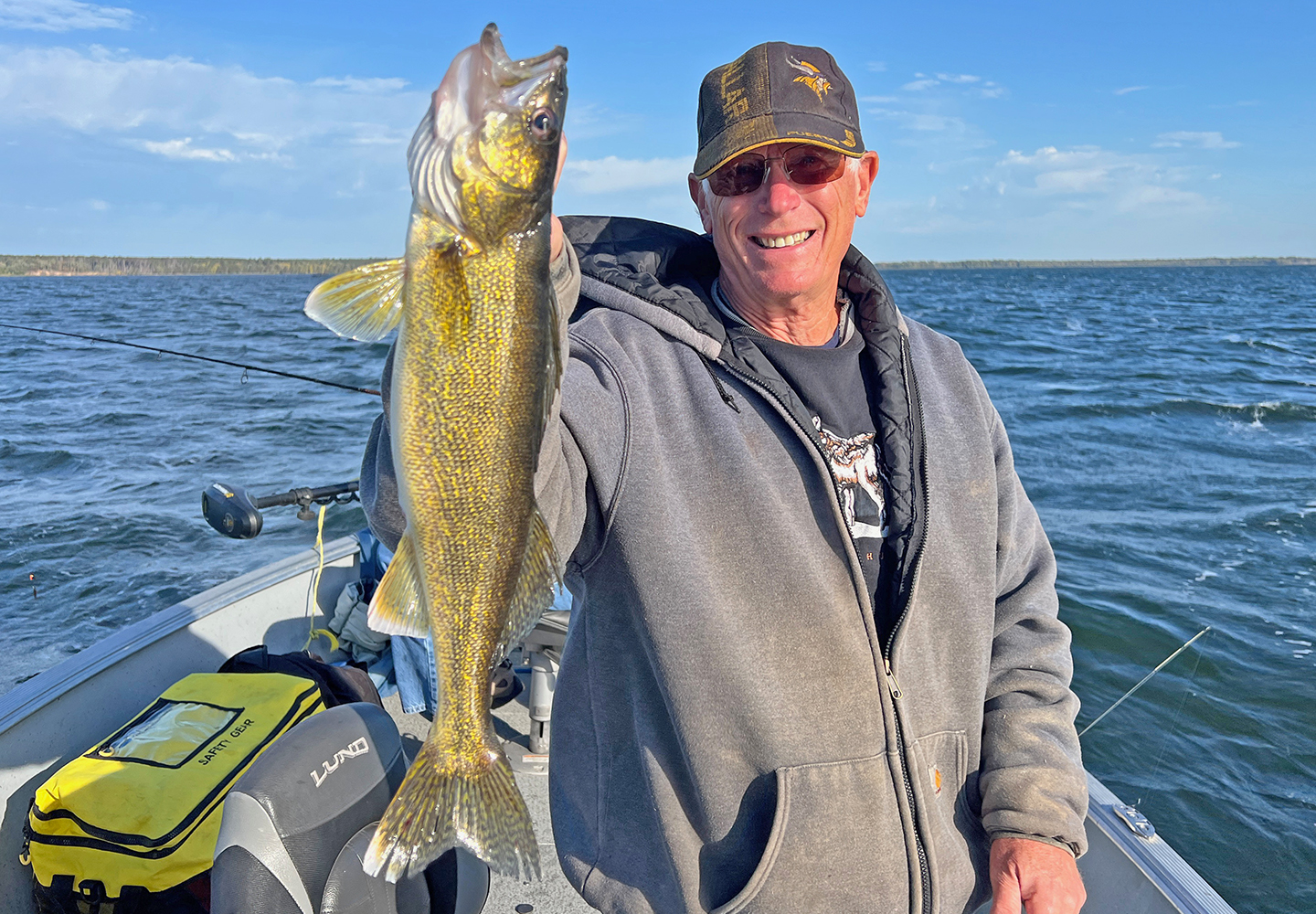 The day before, Monday, I fished on Lake Winnie and it may turn out to be the last summer-like day of the season. It began with a warm southeast wind and ended with a wild and wooly west wind as the cold front began bearing down on the lake. For most of the morning, the southeast winds allowed us to fish effectively. But once that west wind started, life became complicated, finding fish-able water was difficult. For that reason, I’m not sure that the fishing report will remain accurate very long so take it with a grain of salt.
The day before, Monday, I fished on Lake Winnie and it may turn out to be the last summer-like day of the season. It began with a warm southeast wind and ended with a wild and wooly west wind as the cold front began bearing down on the lake. For most of the morning, the southeast winds allowed us to fish effectively. But once that west wind started, life became complicated, finding fish-able water was difficult. For that reason, I’m not sure that the fishing report will remain accurate very long so take it with a grain of salt.
Surface temperatures on Monday morning ranged between 66 and 67 degrees. Water clarity was still low, the Secchi disk reading was 7 feet, the same as it was last week.
Trolling spinners tipped with minnows on the weed flats at Little Stony provided decent, but not fast action for us. The key depths were 8 to 10 feet of water, over the tops of low lying weeds. I’d say we got a strike every 5 minutes or so, sometimes they resulted in a keeper walleye, sometimes keeper perch, and occasionally keeper pike. LOTS of times, the strikes resulted in catching small, 6- to 8-inch-long perch; I’m sorry but if you want to catch the “good ones”, you’ll have to put up with the tiny ones too.
You’ll also have to “put up with” catching walleyes in the protected slot; many of them, just barely over the 18-inch threshold. I’d say that 1/3 of the total are fish over 18 inches, 1/3 of them are yearling walleyes, about 10 inches long, and the remaining 1/3 of them are “keepers”. Our total harvest that day was 10 walleye, 13 perch and 4 pike; not bad for a 2 person crew.
While we were trolling spinners, Reed Ylitalo was on the lake too and his crew were fishing with jigs and minnows. The area they were fishing on the shoreline break further down the west shoreline, and it was productive too. We texted occasionally and I got the impression that they were catching more perch, more pike, and more slot-fish than we were. I’m not sure how their total catch turned out, but I’m sure it was pretty good as well.
Getting an accurate post cold front report from Lake Winnie will take me a couple of days. I had a health-related cancellation for today and tomorrow and have chosen to use this time for taking care of my own concerns. My work schedule is not over yet, and I’ll be back on the water for another dozen charters, beginning this Friday. So, I’ll let you what’s happening out there as soon as I can. ![]() — Jeff Sundin, The Early Bird Fishing Guide Office Cell Call or Text 218-245-9858 or Email
— Jeff Sundin, The Early Bird Fishing Guide Office Cell Call or Text 218-245-9858 or Email
 Ely Area, Arrowhead Outdoors Fishing Report October 2, 2024
Ely Area, Arrowhead Outdoors Fishing Report October 2, 2024
 "Walleye - Some good news on the walleye front has been coming in this last week. Walleyes are starting to hit big minnows and slowly transitioning to traditional fall locations like sharp breaks and deeper water. These walleyes have been hitting large minnows fished on a jig or lindy rig in 15 to 20 feet of water. That being said, reports continue to come in of nice walleyes being caught over shallow rocks, 5 to 10 feet of water, with paddle tails and scattered walleyes being caught trolling crankbaits over 25 to 30 foot deep flats.
"Walleye - Some good news on the walleye front has been coming in this last week. Walleyes are starting to hit big minnows and slowly transitioning to traditional fall locations like sharp breaks and deeper water. These walleyes have been hitting large minnows fished on a jig or lindy rig in 15 to 20 feet of water. That being said, reports continue to come in of nice walleyes being caught over shallow rocks, 5 to 10 feet of water, with paddle tails and scattered walleyes being caught trolling crankbaits over 25 to 30 foot deep flats.
Smallmouth - Smallmouth bite remained on fire this last week. Water temps still have the smallies scattered for the most part, but pockets of fat, aggressive smallies are starting to group up on sunken islands. Shallow sunken islands that top out in 12 to 15 feet have been the best ones to find groups of active smallies. Large minnows and large paddle tails slow rolled over these humps have been deadly
Panfish - Anglers have been reporting that some good crappie bites have been happening in many Ely area lakes. Crappies are slowly starting to school up. Anglers are still finding crappies in and around weedbeds on area lakes. Anglers should not overlook trees laying in the water and standing timber in some area lakes. Jig/twister, beetle spins and crappie minnows fished under a bobber.
Pike - Pike fishing has remained on the slow side this last week, but that doesn't mean trophy pike were not caught this last week. Pike anglers have been focusing on mouths of shallow bays, rocky points and river mouths to find big pike. Large suckers fished under a bobber accounted for the majority of 40 plus inch pike caught this last week. Large spoons, spinnerbaits and crankbaits were also effective.
Stream Trout - Rainbow trout remain a popular trout to target for trout anglers. Night crawlers fished 5 to 10 feet deep under a bobber remain very effective. Small spoons, spinners and jig/twisters have also been effective on rainbows. Anglers fishing from a boat have been having good luck trolling small crankbaits over deep water and along standing timber.
Lake Trout - Season is closed inside and outside the BWCA." — Arrowhead Outdoors, 218-365-5358
 Lake of the Woods, LOW Tourism October 1, 2024
Lake of the Woods, LOW Tourism October 1, 2024
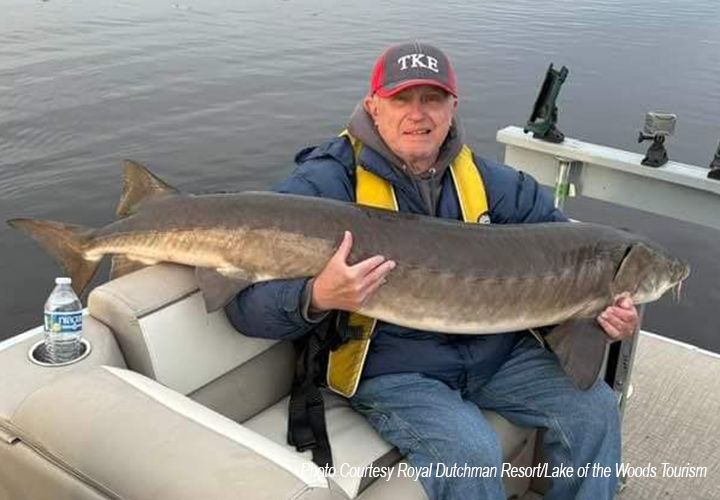 "Walleye and sauger fishing is very good on the south end of Lake of the Woods. Routine reports of anglers catching good numbers of fish are common. So, if you want to catch some numbers, the bite is on. Anglers are finding fish ranging from 24 to 31 feet deep across the south shore of Lake of the Woods. Some really nice perch and an occasional pike are being caught mixed in with the walleyes and saugers.
"Walleye and sauger fishing is very good on the south end of Lake of the Woods. Routine reports of anglers catching good numbers of fish are common. So, if you want to catch some numbers, the bite is on. Anglers are finding fish ranging from 24 to 31 feet deep across the south shore of Lake of the Woods. Some really nice perch and an occasional pike are being caught mixed in with the walleyes and saugers.
Best areas to fish range from right in front of the Lighthouse Gap (where the Rainy River enters Lake of the Woods) and westward to spots near the Morris Point area, Zippel Bay area, and all the way over to Long Point, these areas of the lake are all producing fish right now. There aren't fish everywhere but there are various schools spread out across the entire south shore of the basin.
Jigging with frozen, or live emerald shiners is the ticket. Locate fish on your sonar, anchor up and give it 30 minutes. If not to your liking, relocate different fish and repeat. Normally things will work out nicely over the course of the day. Successful jig colors in the stained waters of LOW are gold, glow white, glow red, chartreuse, orange, and pink. Gold combined with any one of these colors is often a good choice. Drifting spinners with night crawlers or trolling crankbaits is still working for anglers as well.
For the anglers targeting smallmouth bass, there is a good bite on both the lake and Rainy River. The river also continues to produce some nice walleyes. There are some schools of shiners moning up and down the river and consequently, some nice walleyes in the river too. Nobody is reporting that the heavy run has begun yet, but the bite is respectable for sure. The river, being relatively small, provides a great option for anglers with small boats. With a variety of boat ramps from the mouth of the river all the way to up the river to Birchdale, there are many options to choose from.
Sturgeon fishing continues to pick up as water temps cool. The sturgeon is catch and release from October 1, 2024 into the month of April, 2025 when you can keep one again.
Up at the Northwest Angle, walleye fishing remains strong on both sides of the border. Walleyes are using a variety of areas from mud flats to various areas with structure and neck down areas with some current.
It's fall, which means a mixed bag of fish is common in these parts. Walleyes, saugers, jumbo perch, crappies, pike, smallmouth bass and muskies are all being caught. As water temps cool and the days get shorter, the bite will get even better!" — Lake of the Woods Tourism, (800) 382-FISH
 Wired2Fish September 20, 2024 "How to Identify Size and Species of Fish on FFS"
Wired2Fish September 20, 2024 "How to Identify Size and Species of Fish on FFS"
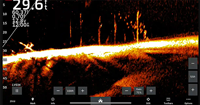 "Though I have been using it longer, I’ve become completely infatuated with forward-facing sonar over the last year and a half. My love for this new technology started during my senior year of college, and since then I’ve dedicated countless days to learning and understanding everything these units can tell you. This has been no easy task, however I’ve slowly started to piece together all the little intricacies associated with forward-facing sonar.
"Though I have been using it longer, I’ve become completely infatuated with forward-facing sonar over the last year and a half. My love for this new technology started during my senior year of college, and since then I’ve dedicated countless days to learning and understanding everything these units can tell you. This has been no easy task, however I’ve slowly started to piece together all the little intricacies associated with forward-facing sonar.
Throughout this journey I’ve learned a few different ways to identify the size and species of fish displayed by forward-facing sonar. This includes paying attention to the sonar return, as well as the fish’s behavior and positioning. These three things can tell you a lot about what’s happening underneath the water, however it still requires an ample amount of fishing time to become proficient with this technology.
One of the first things I figured out while using forward-facing sonar is ..." Learn More >> How to Identify Size and Species of Fish on FFS